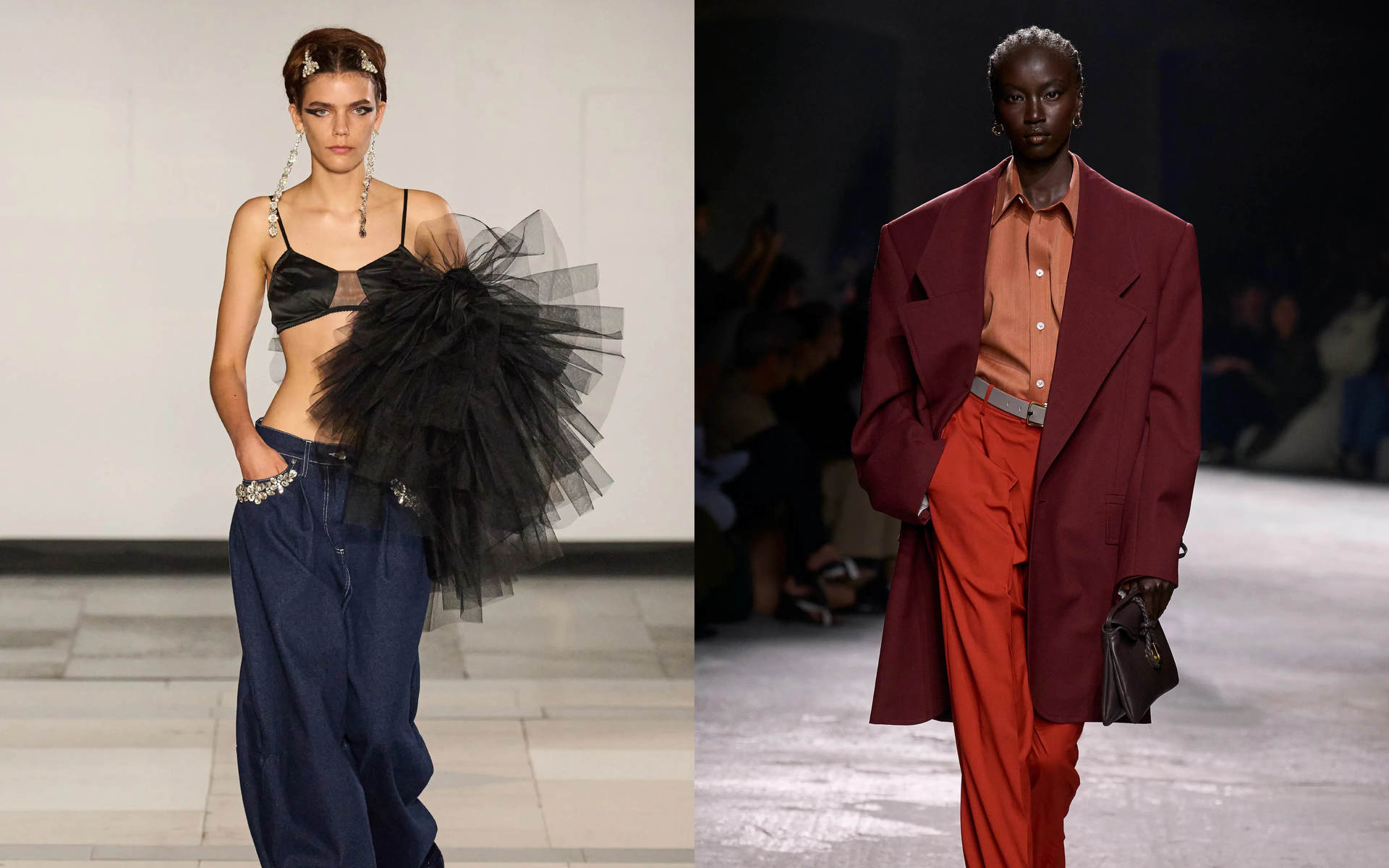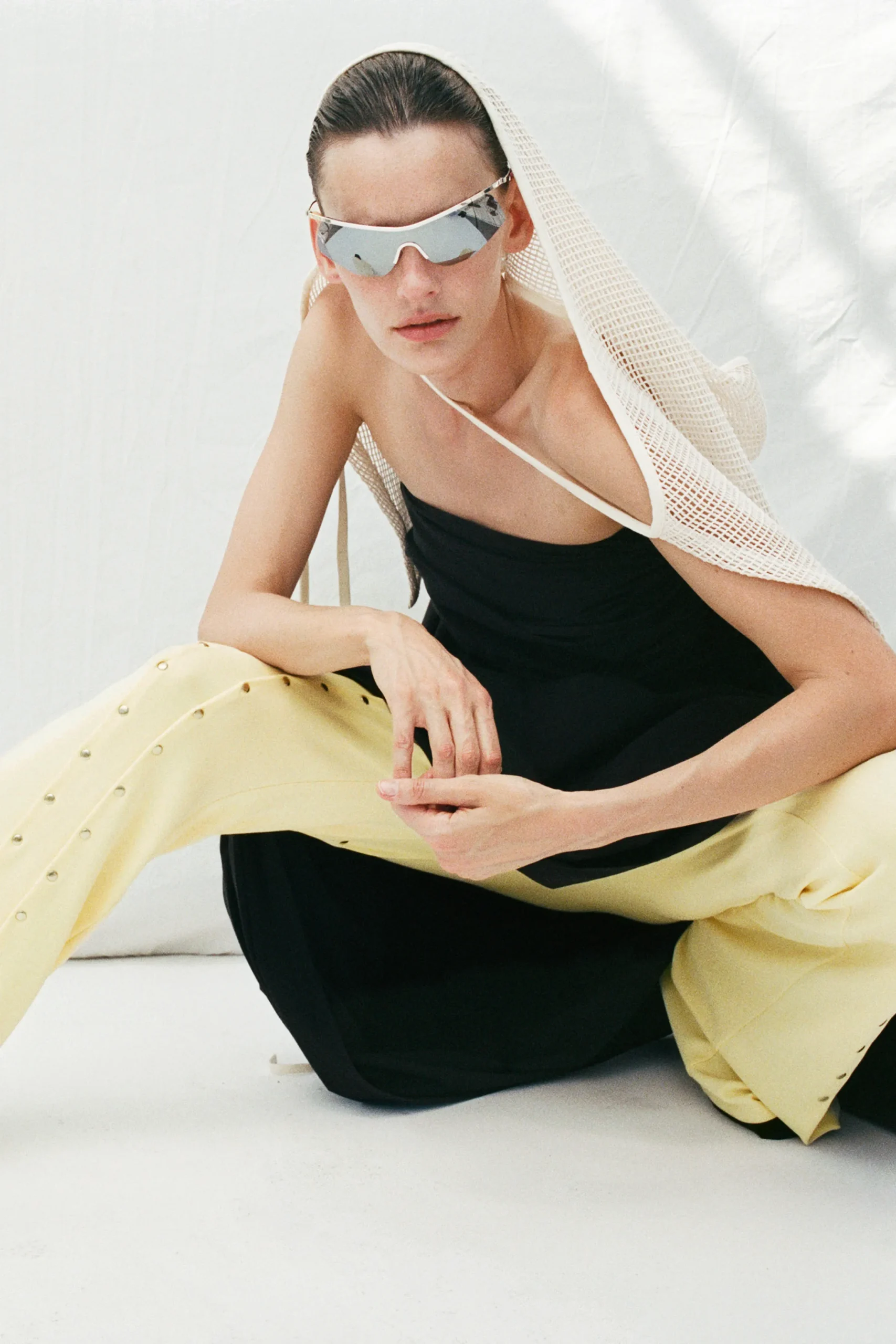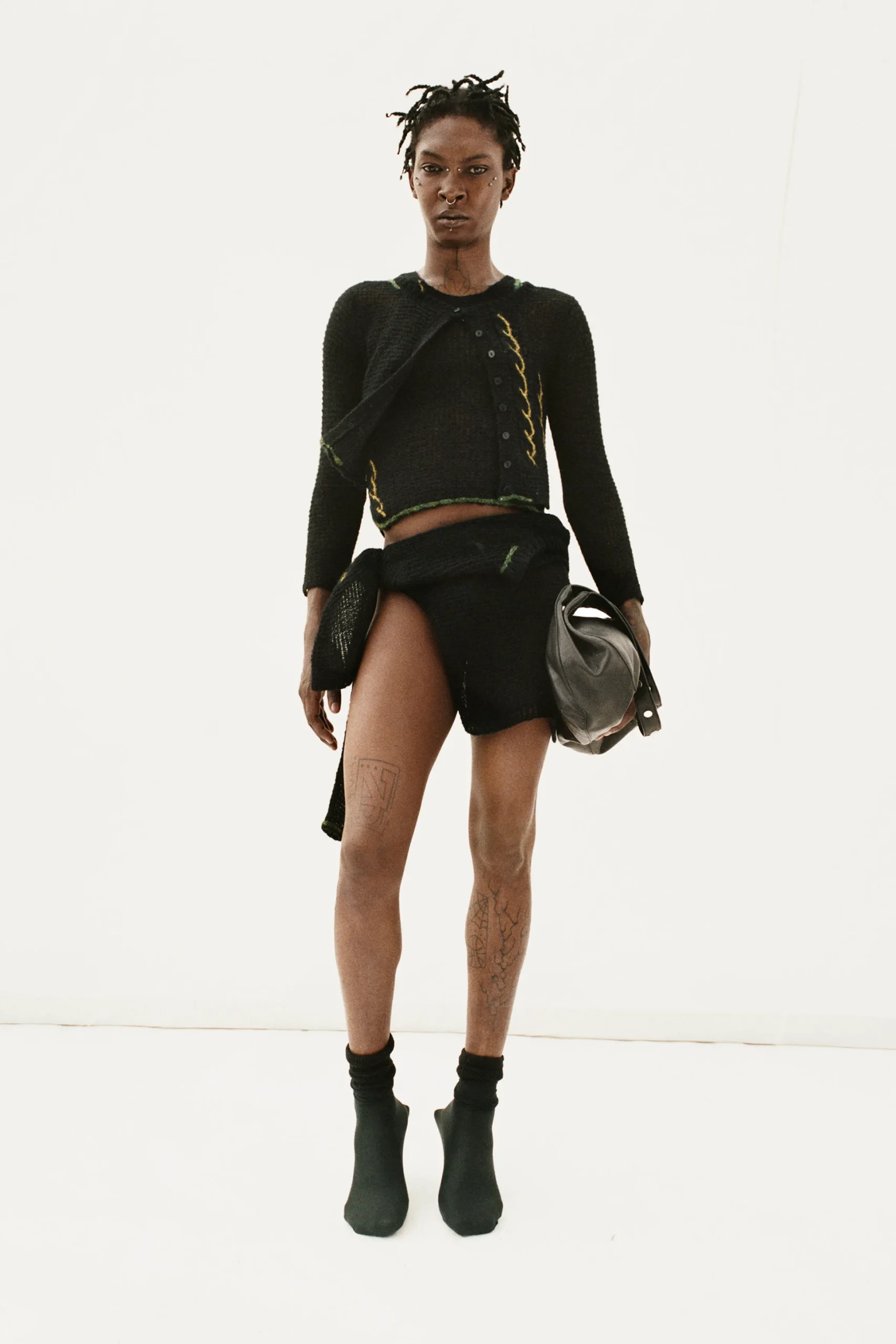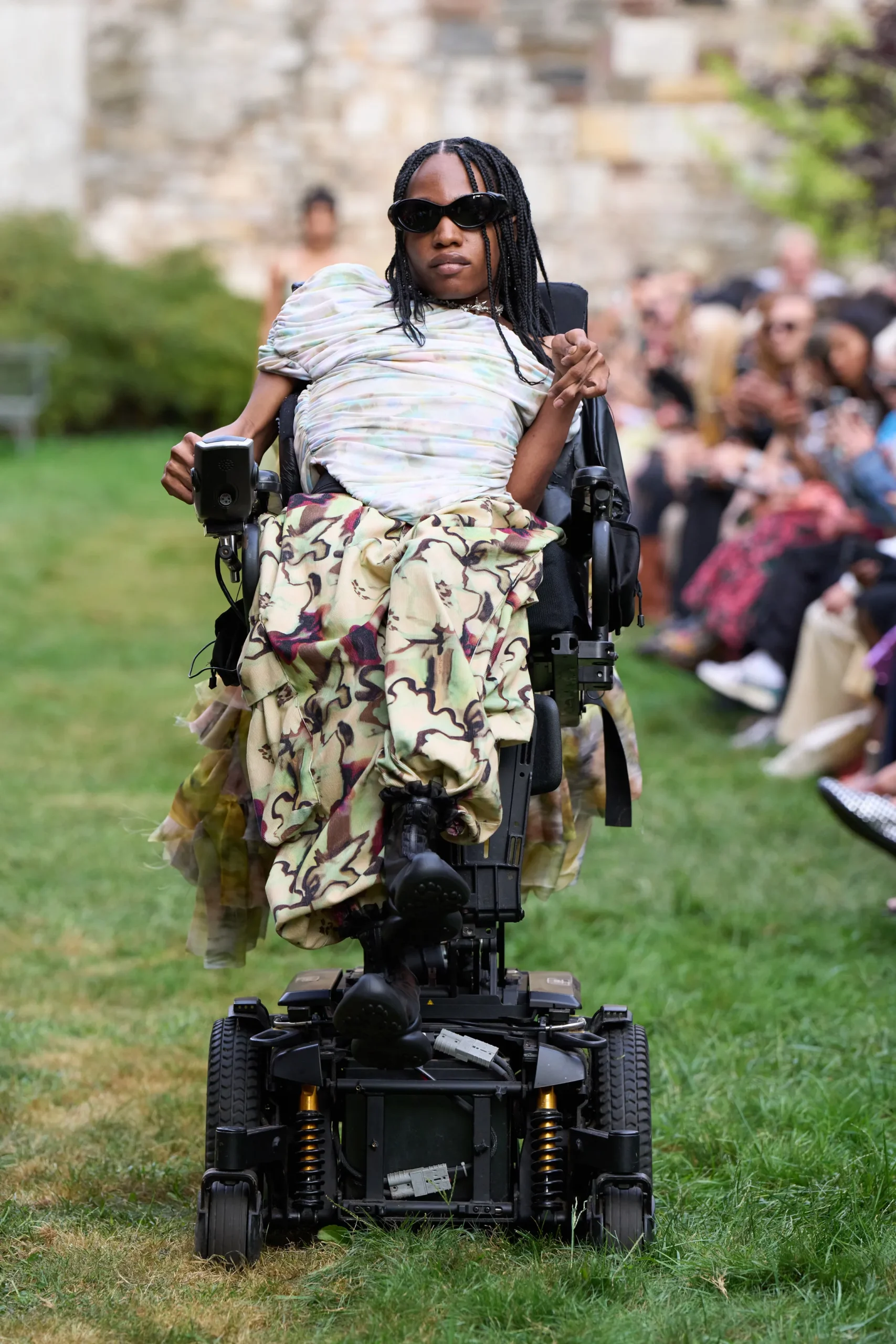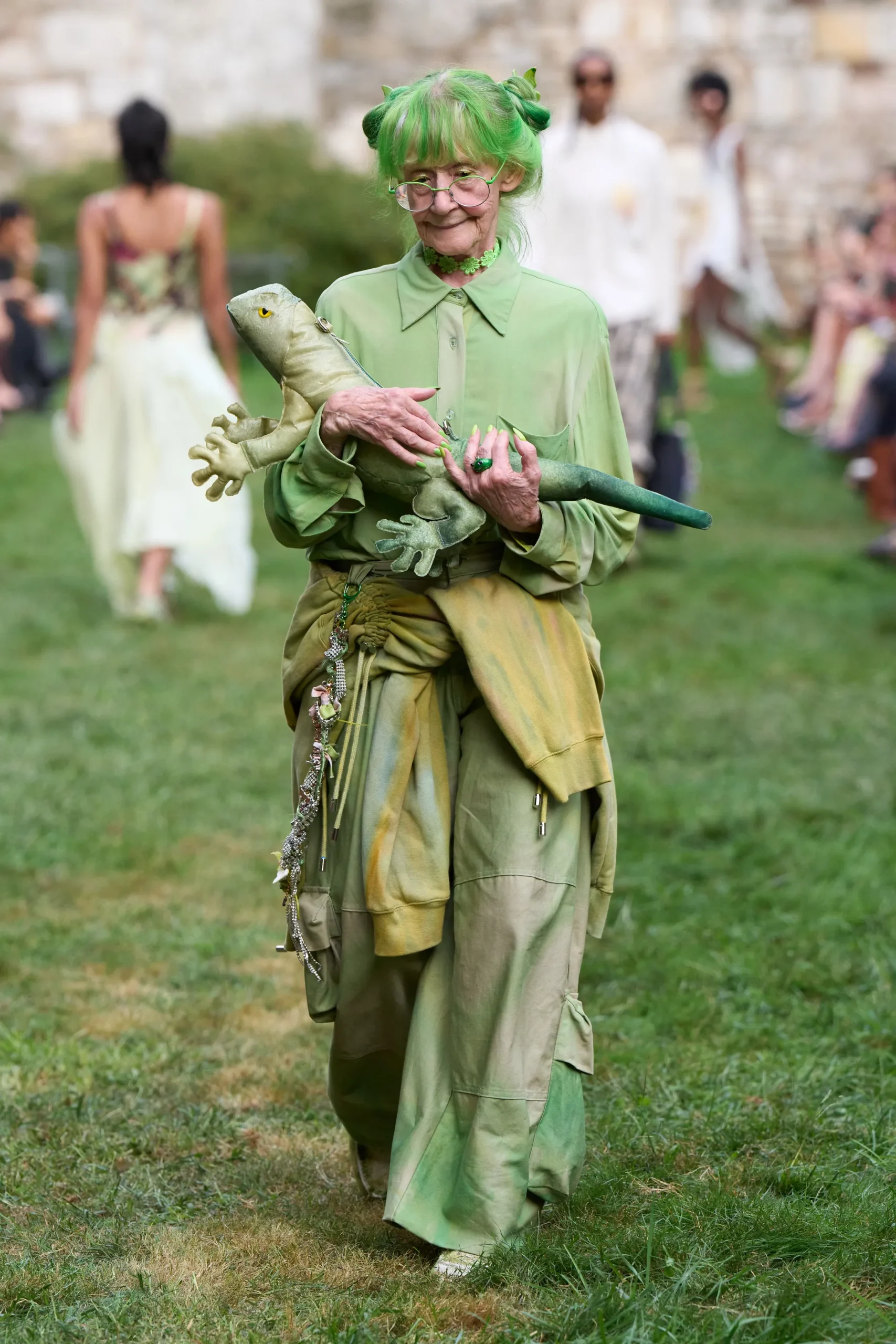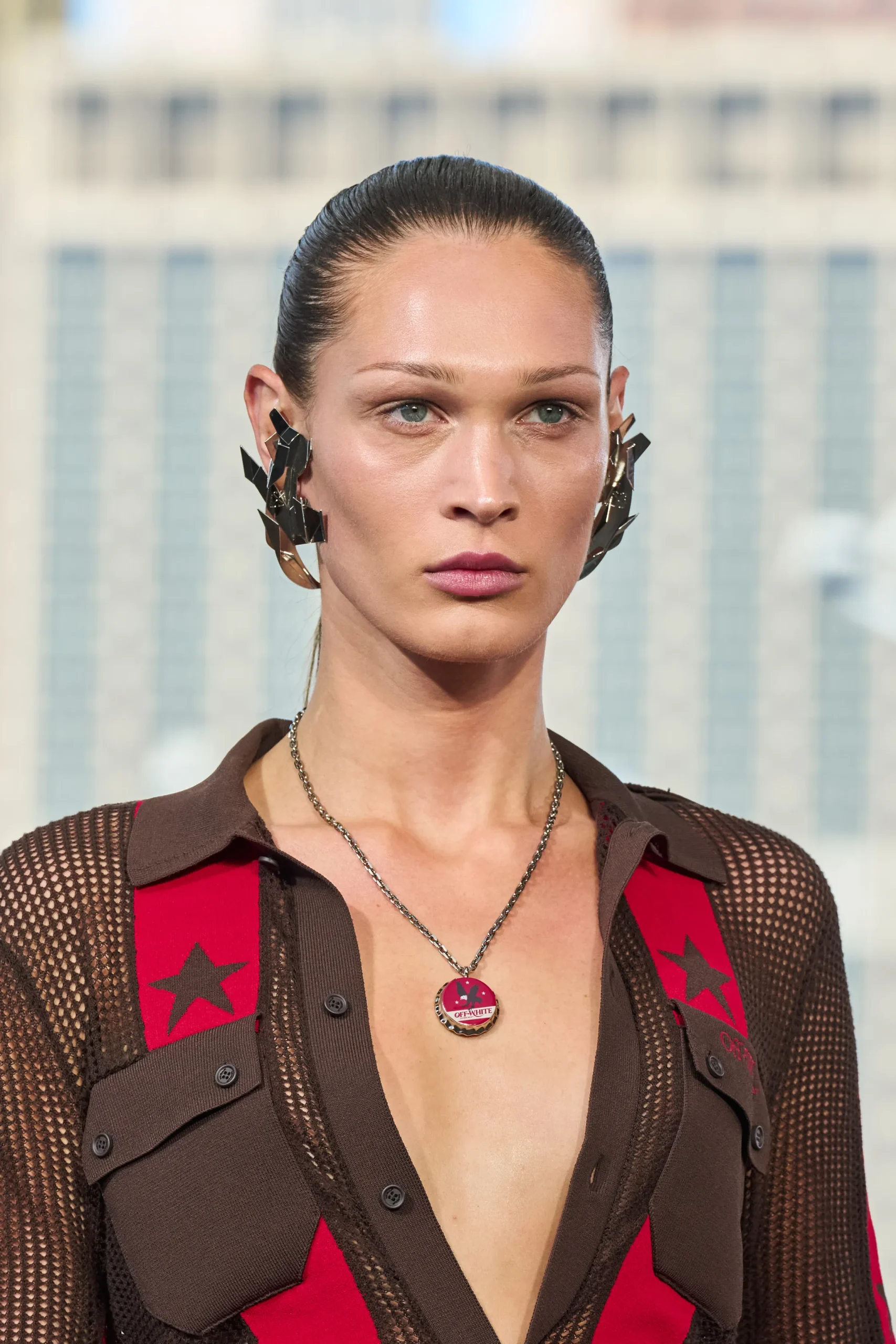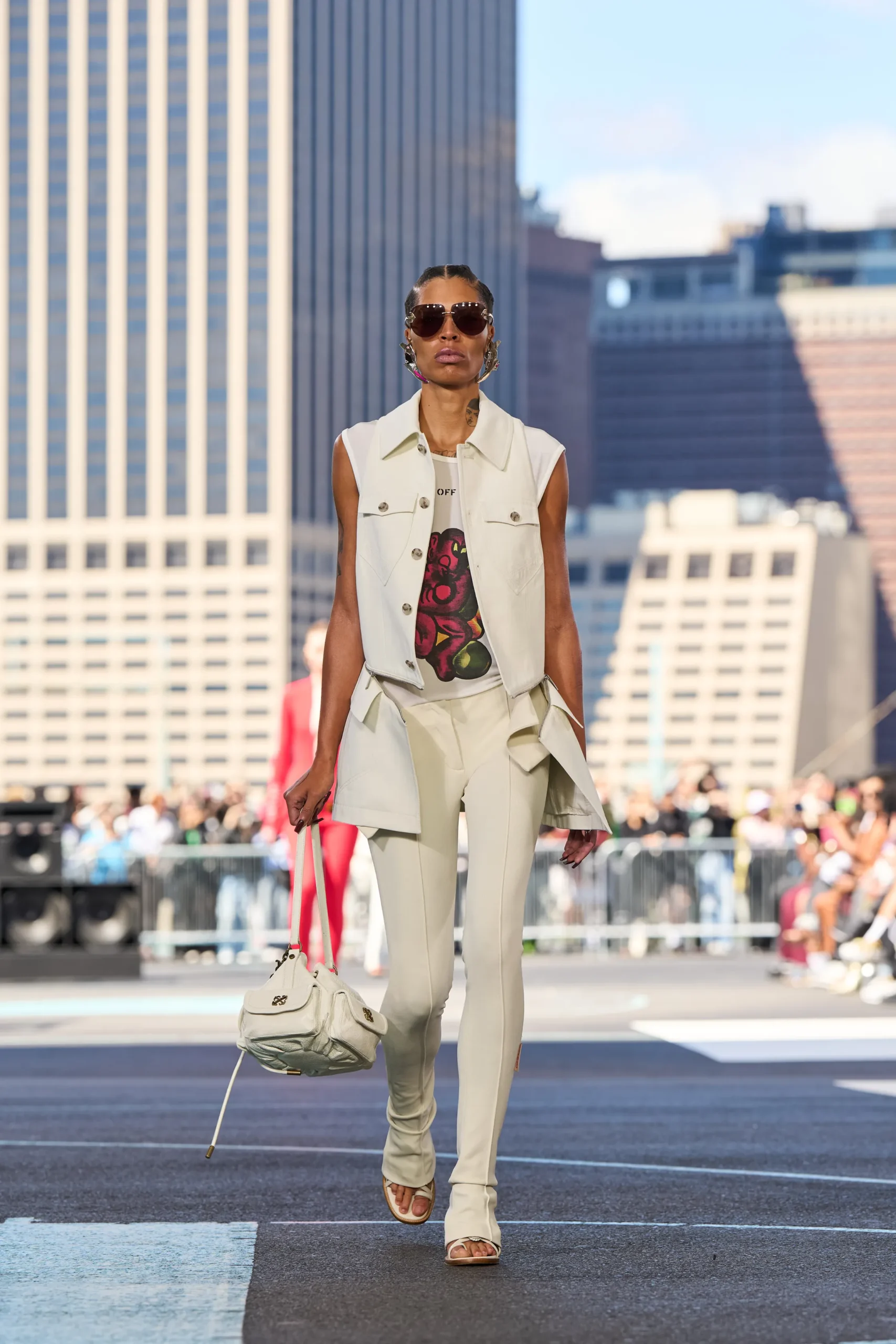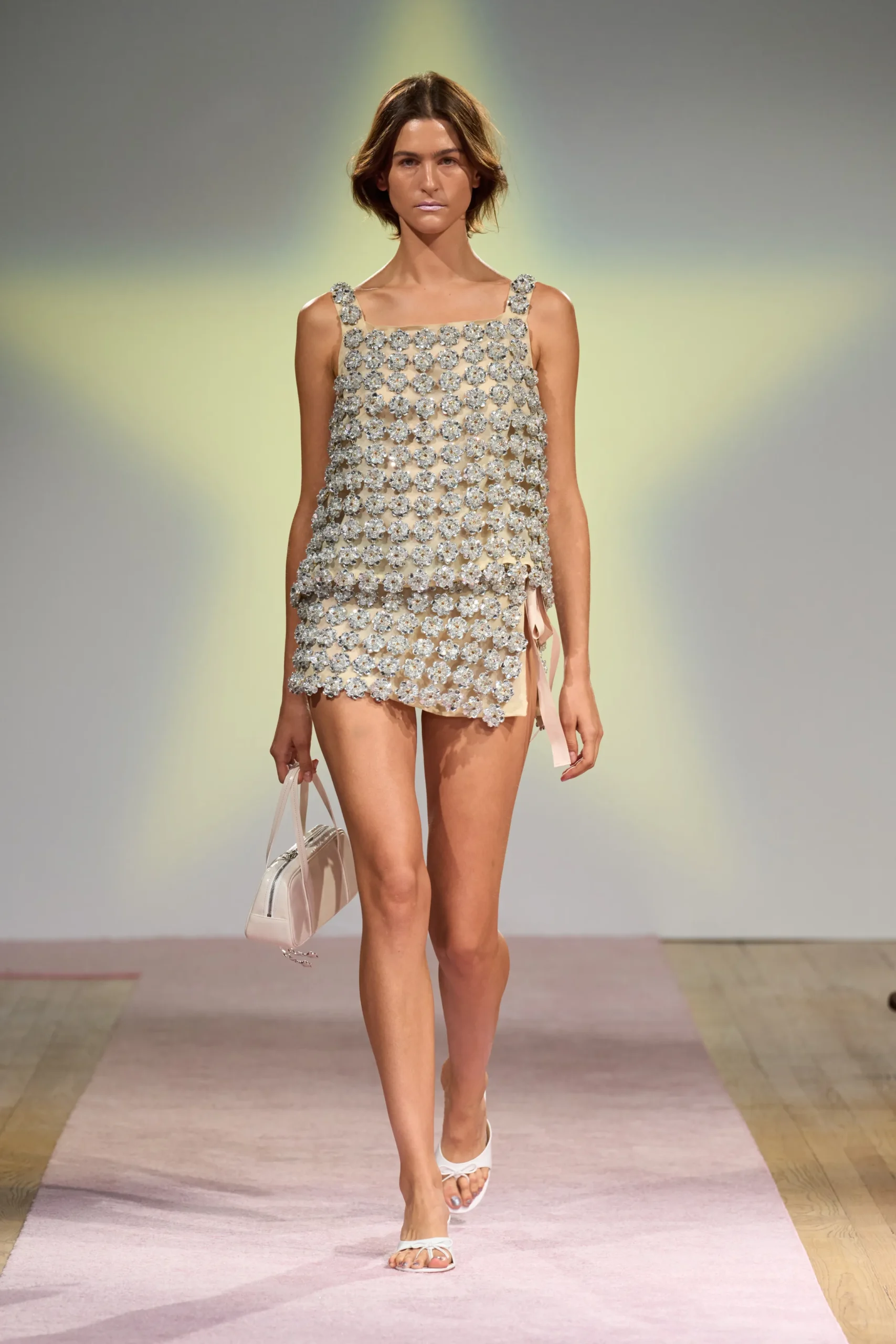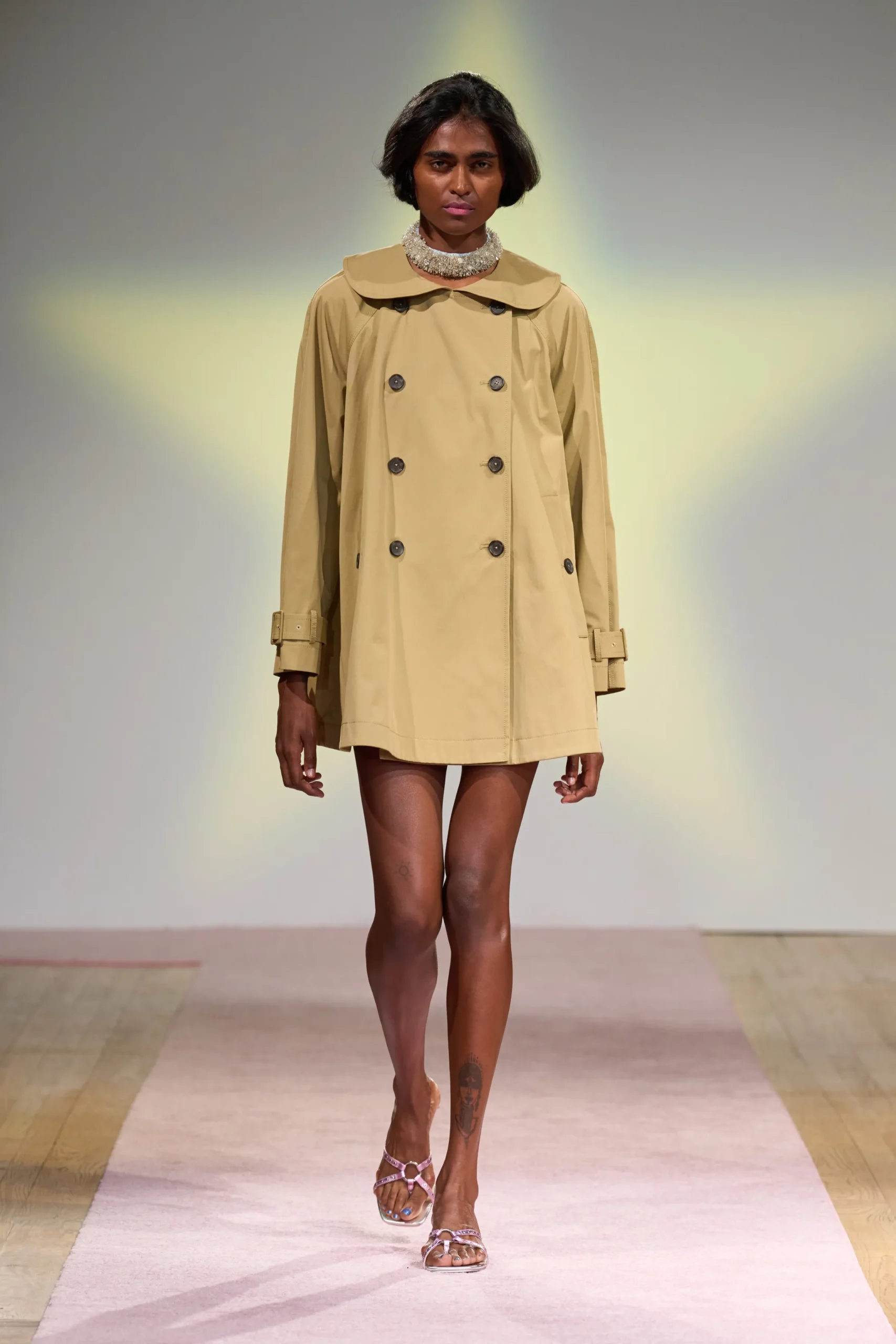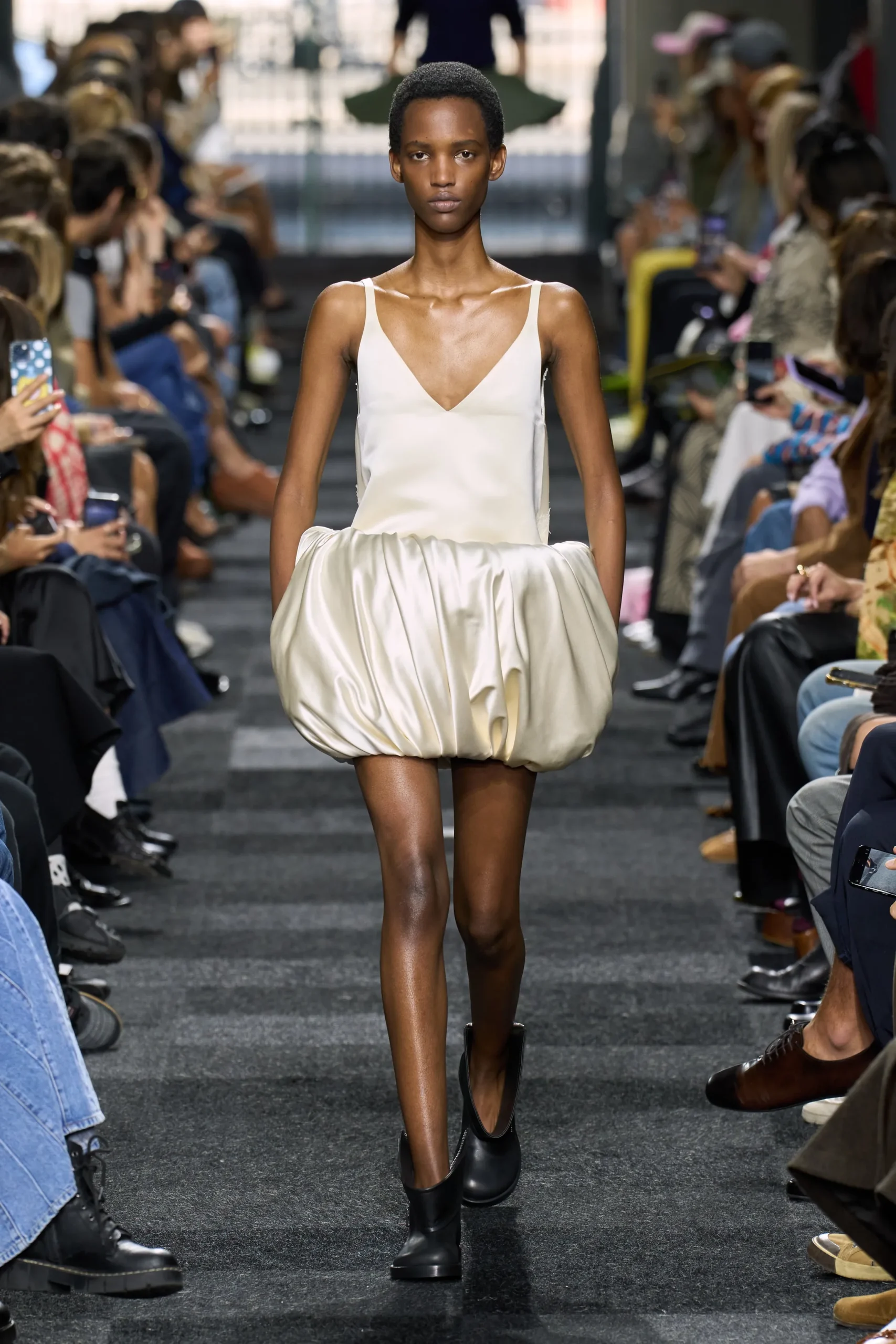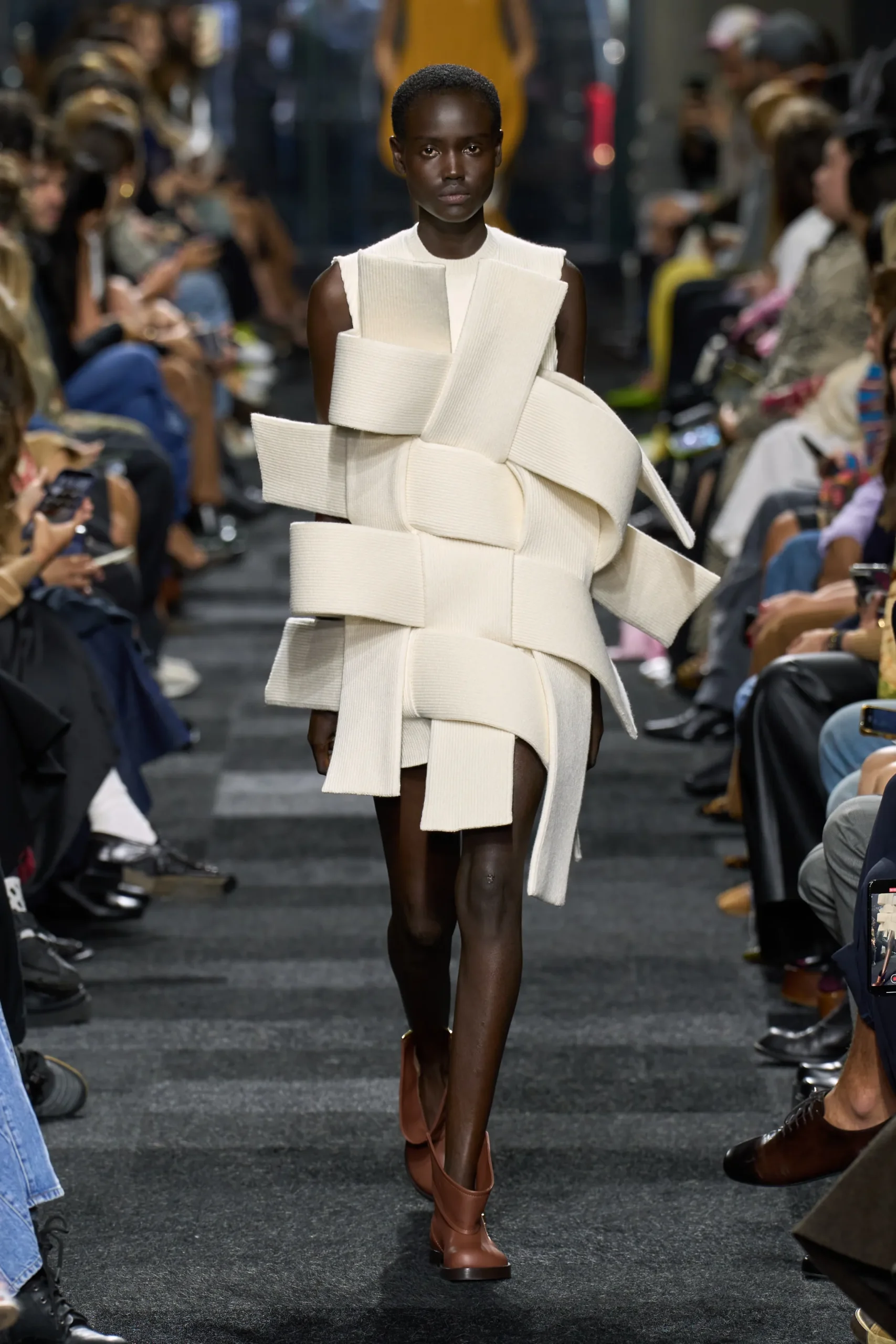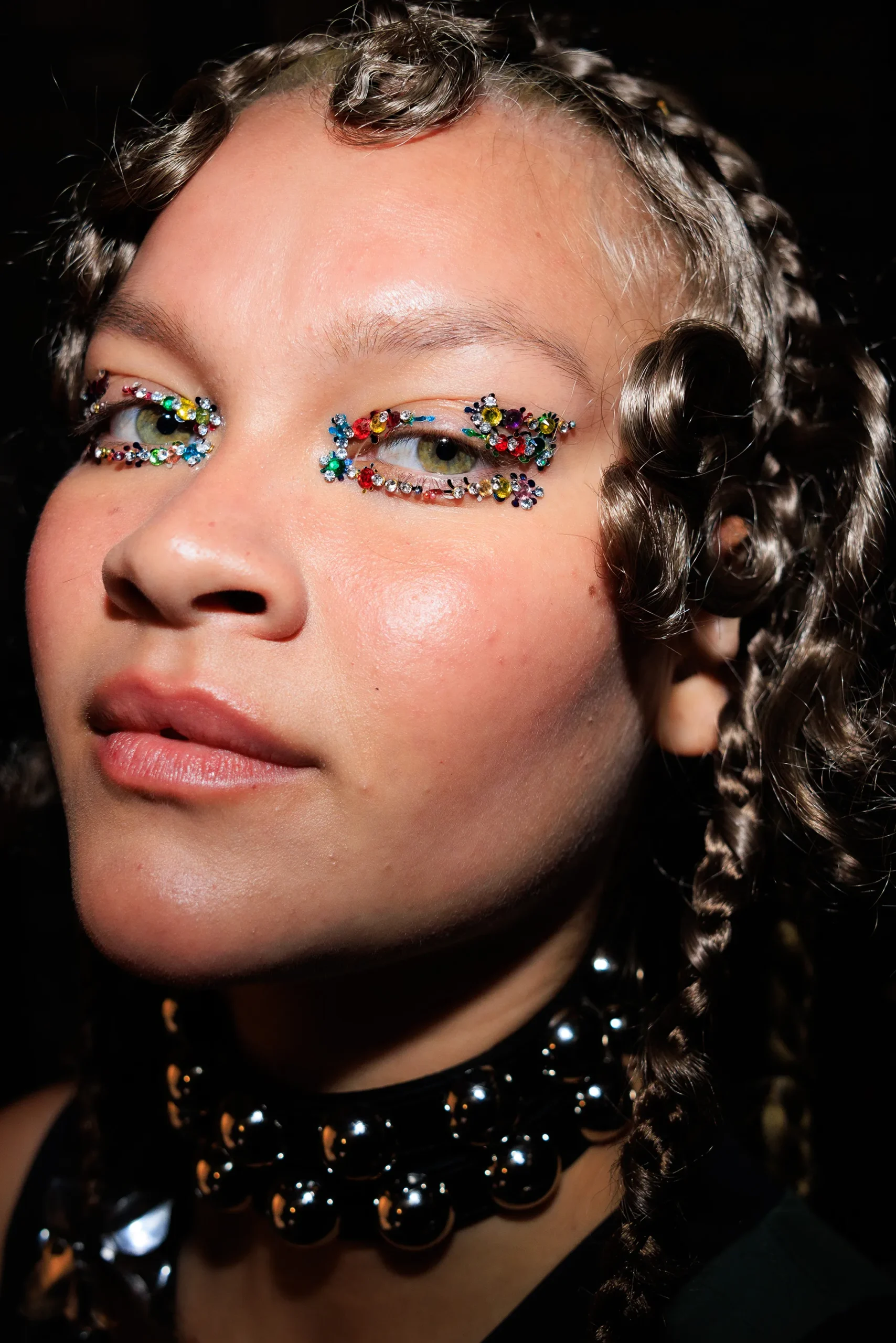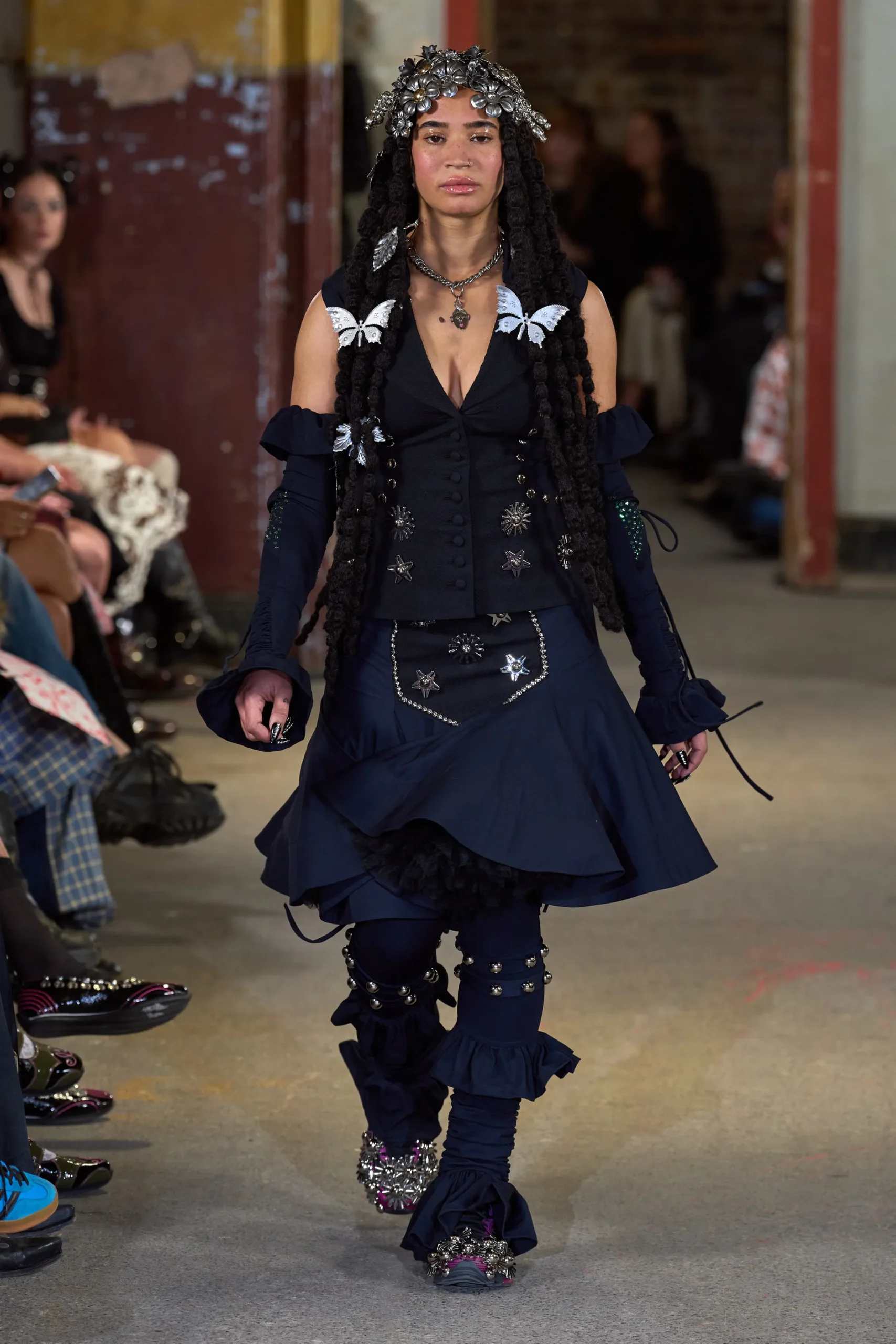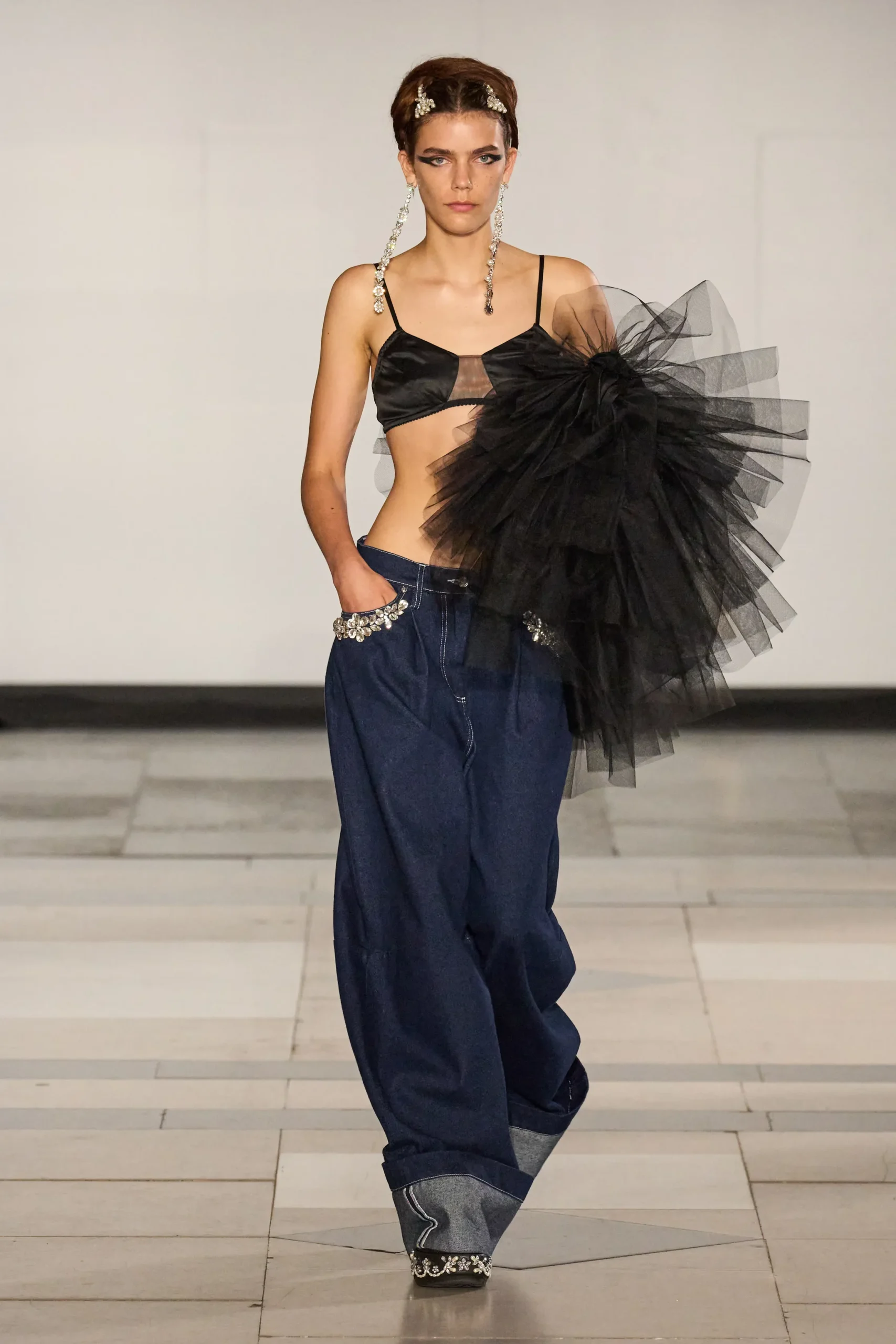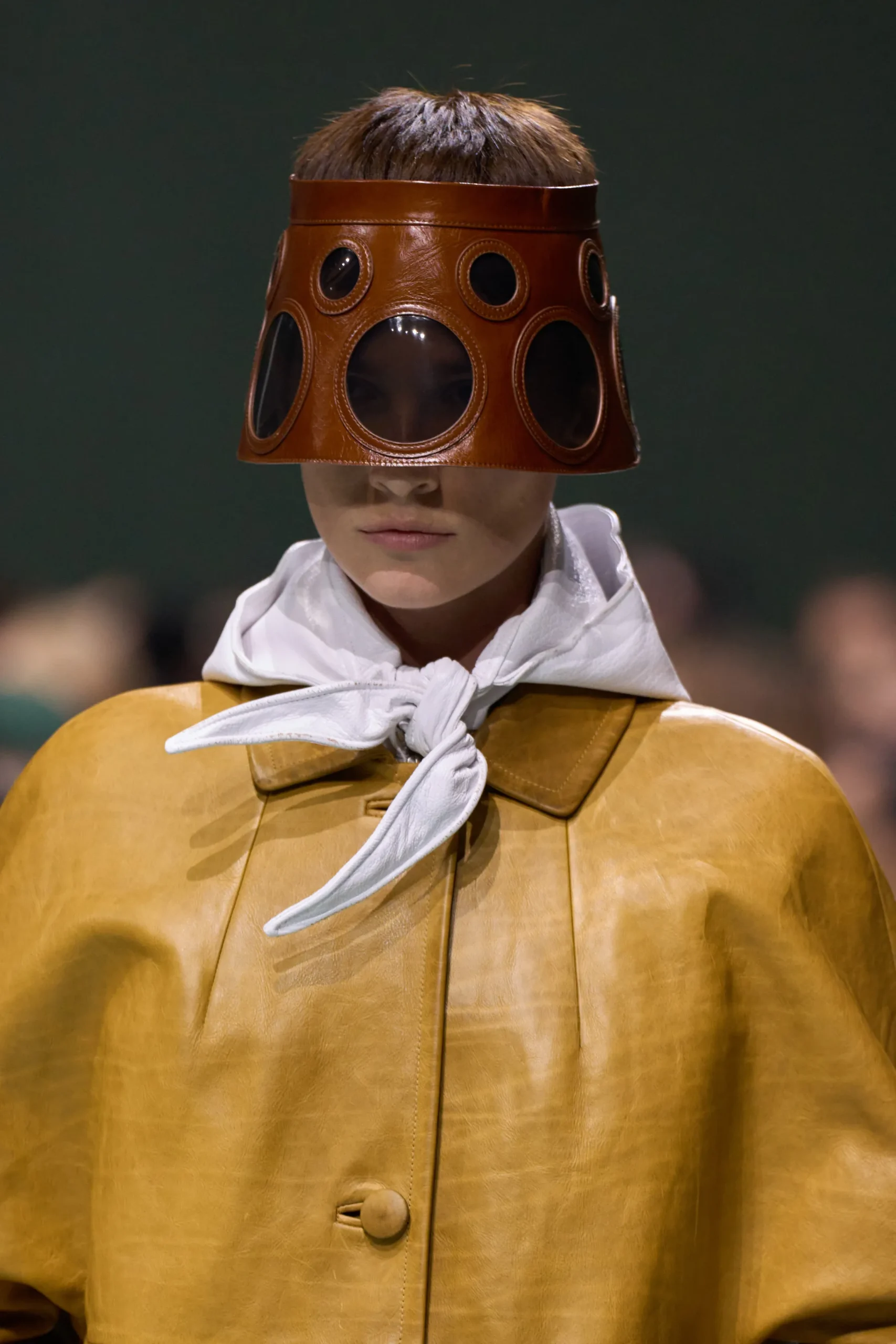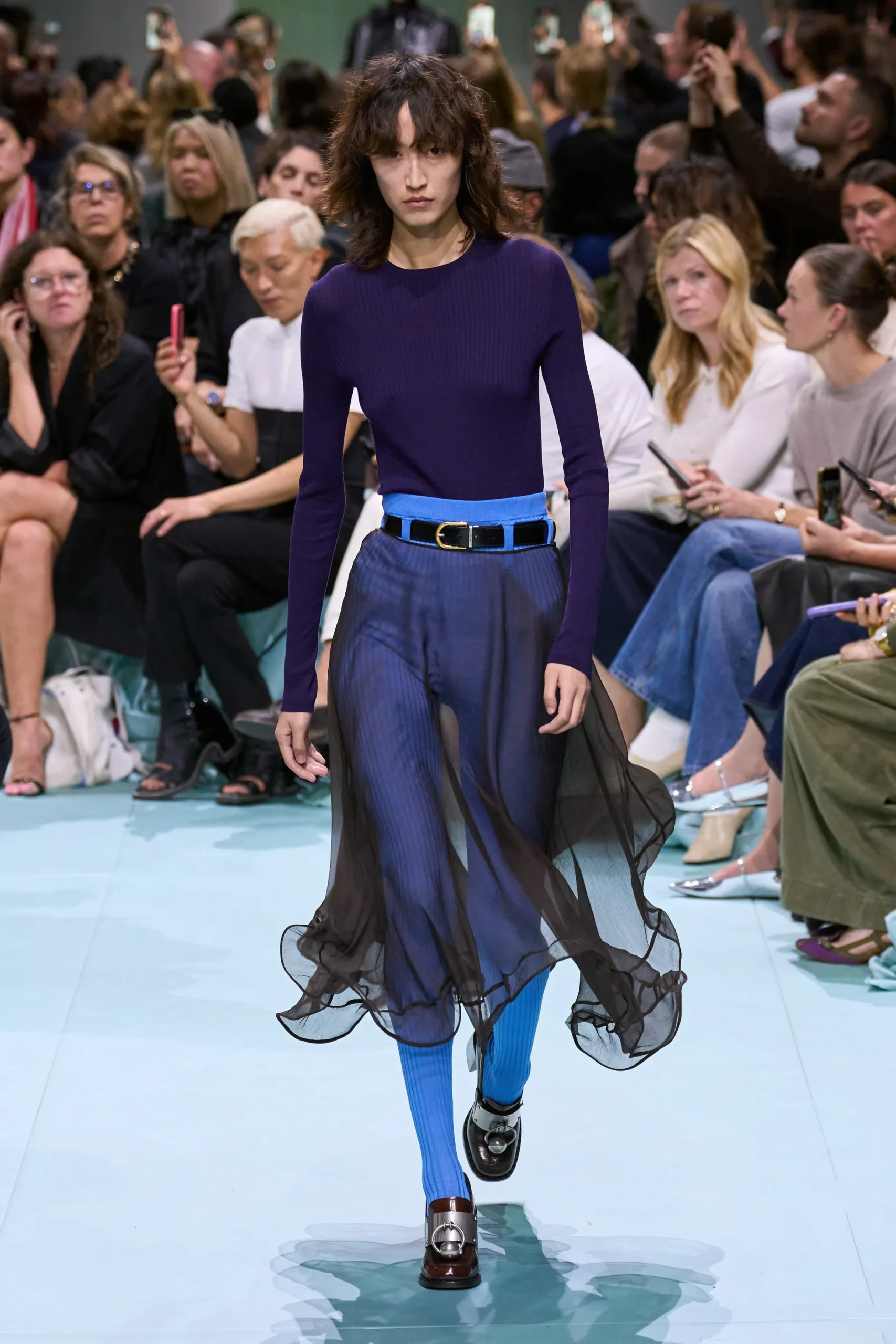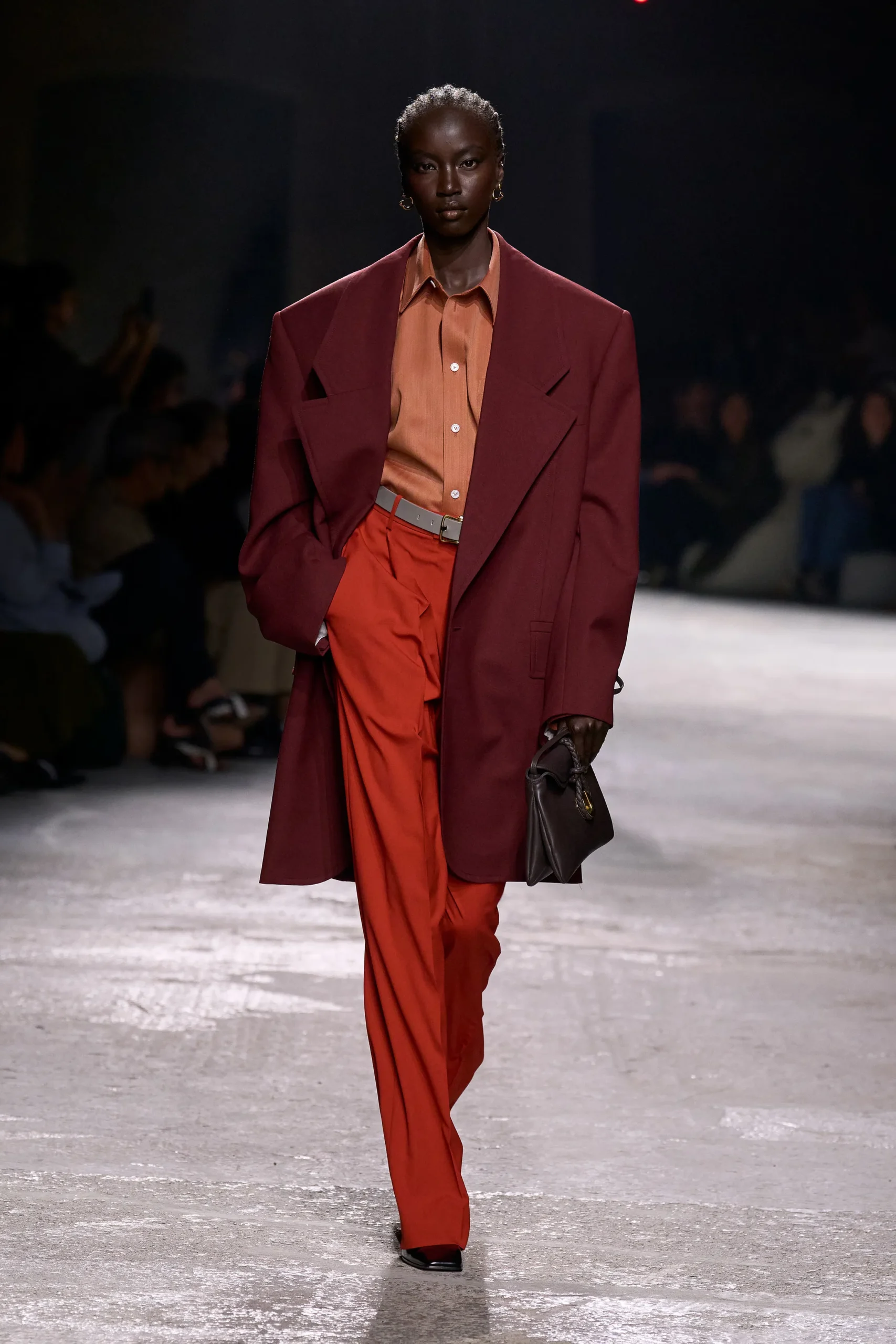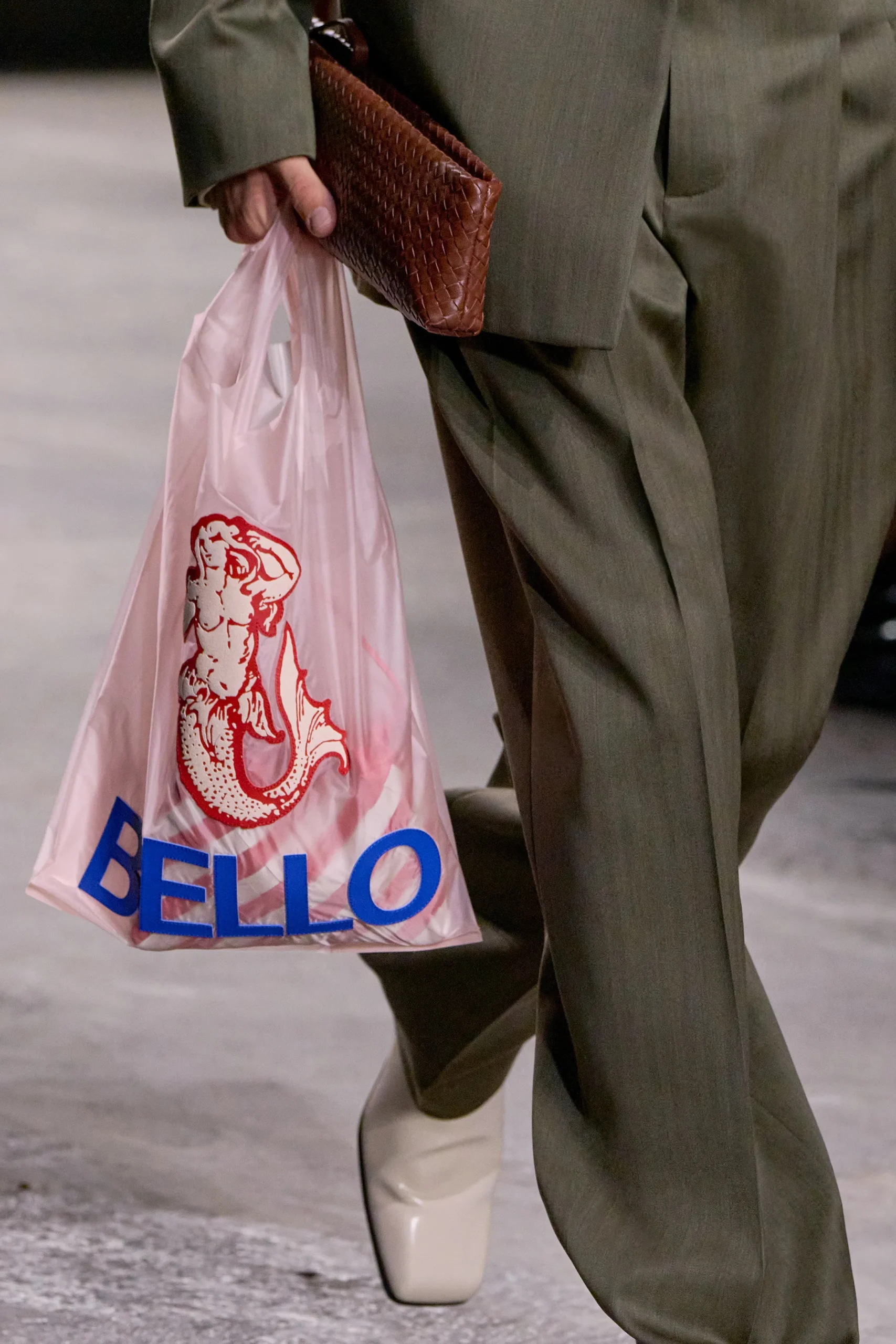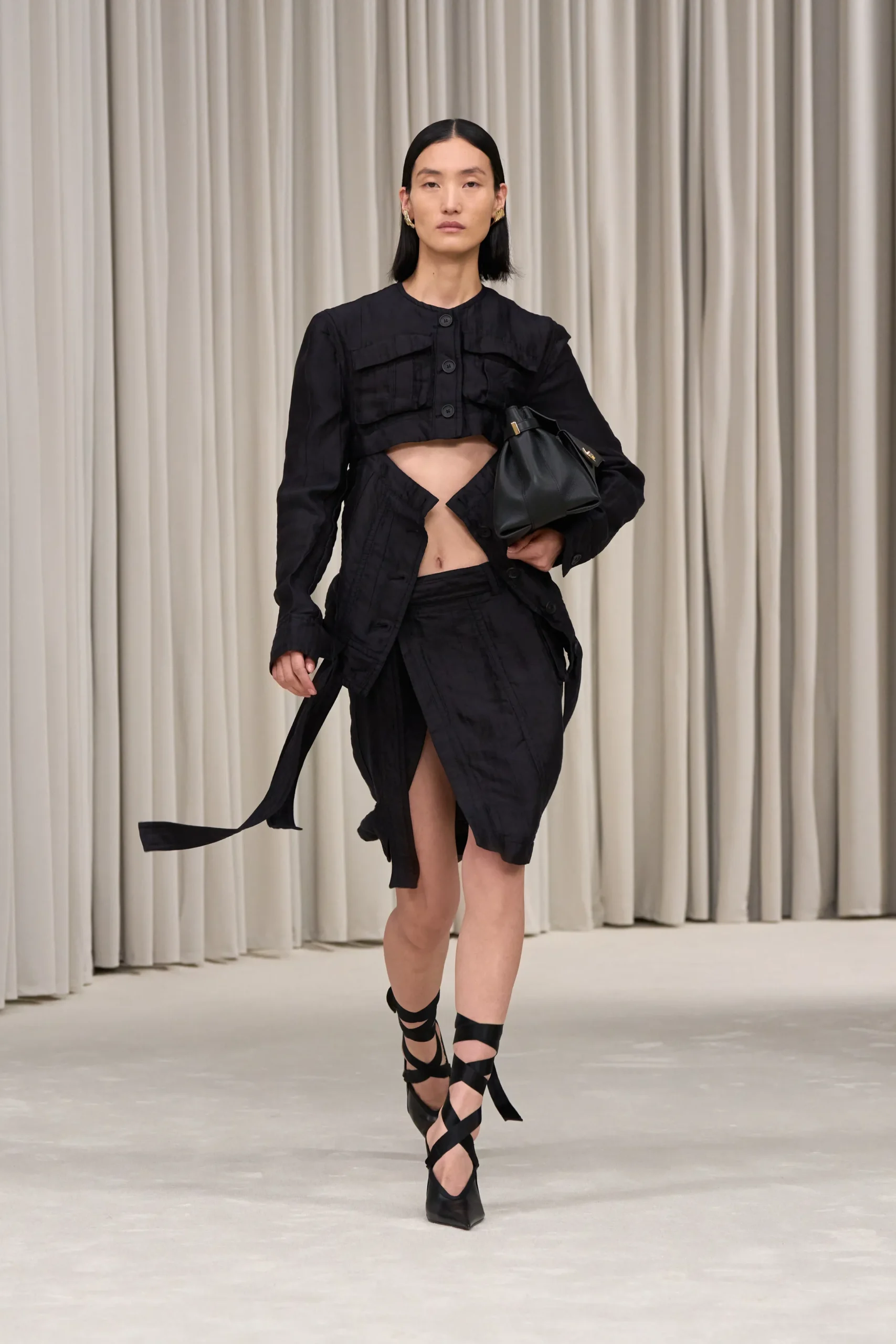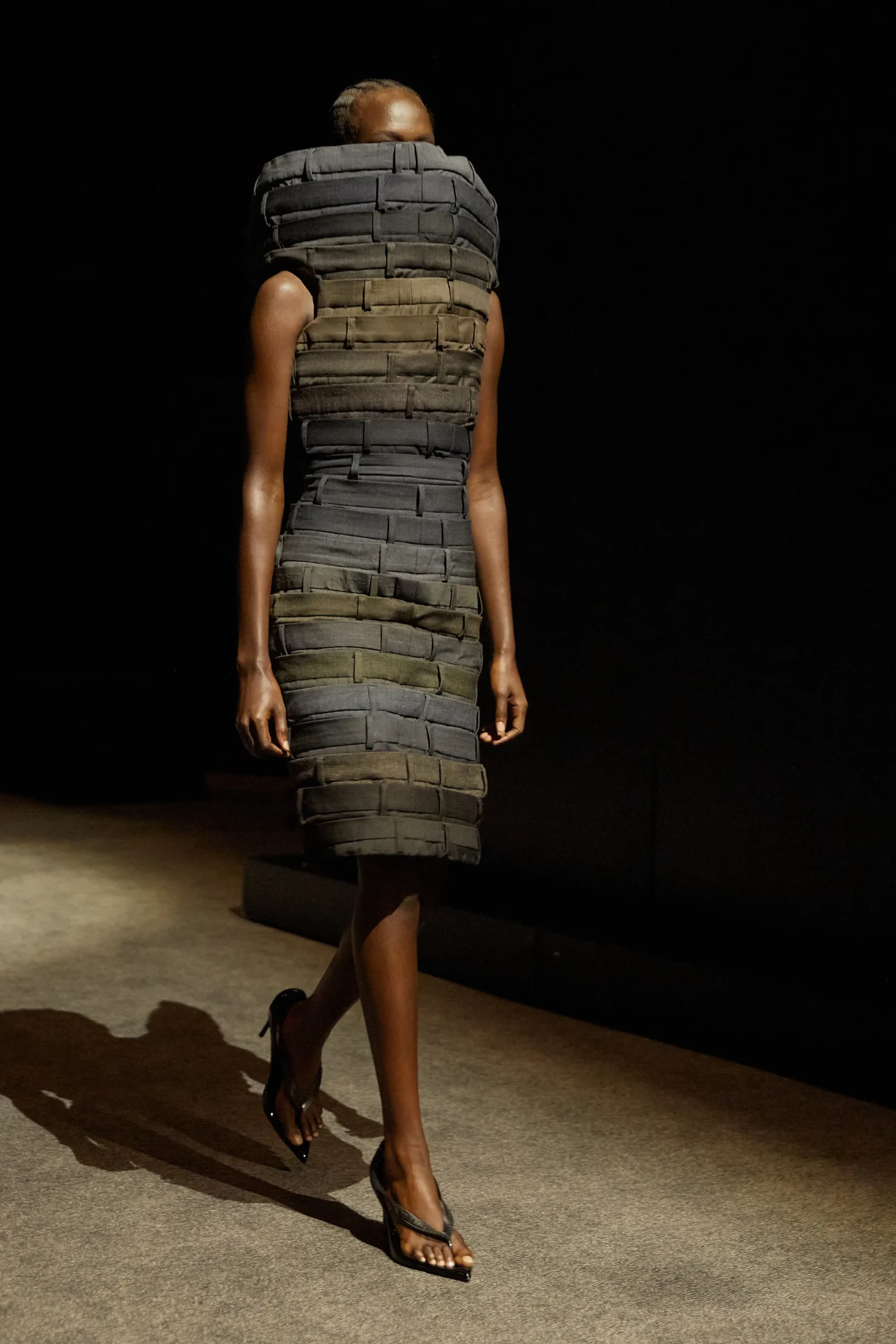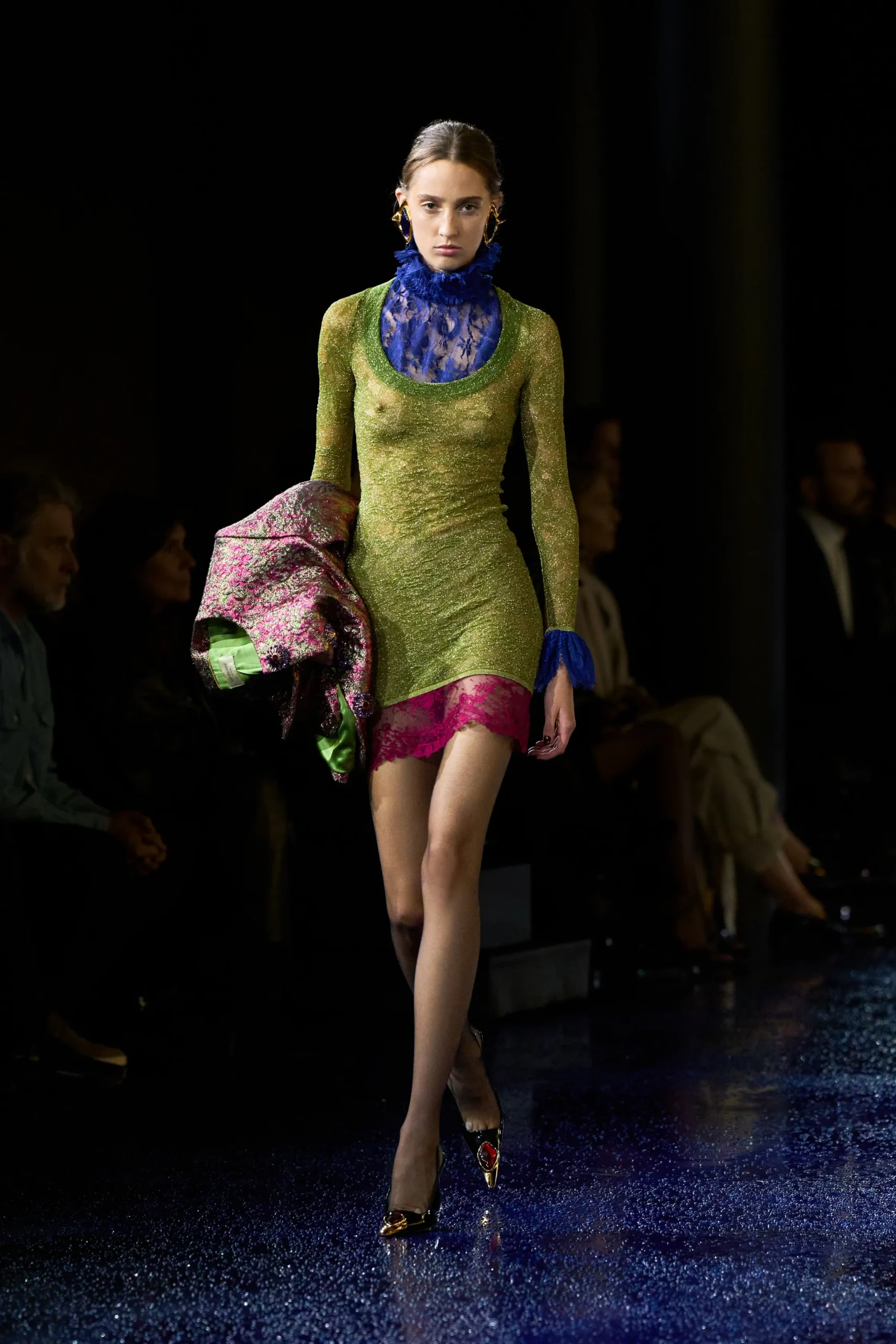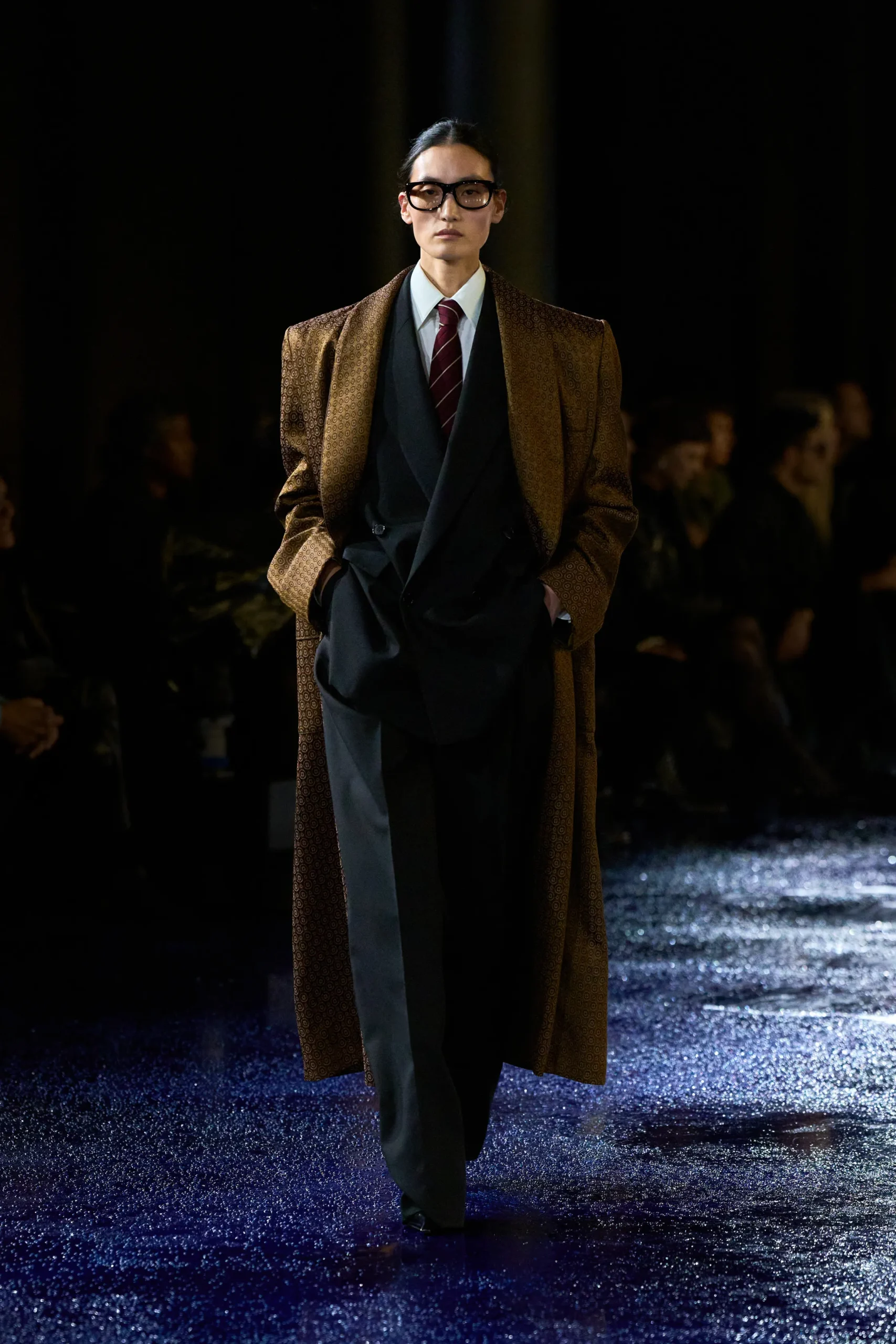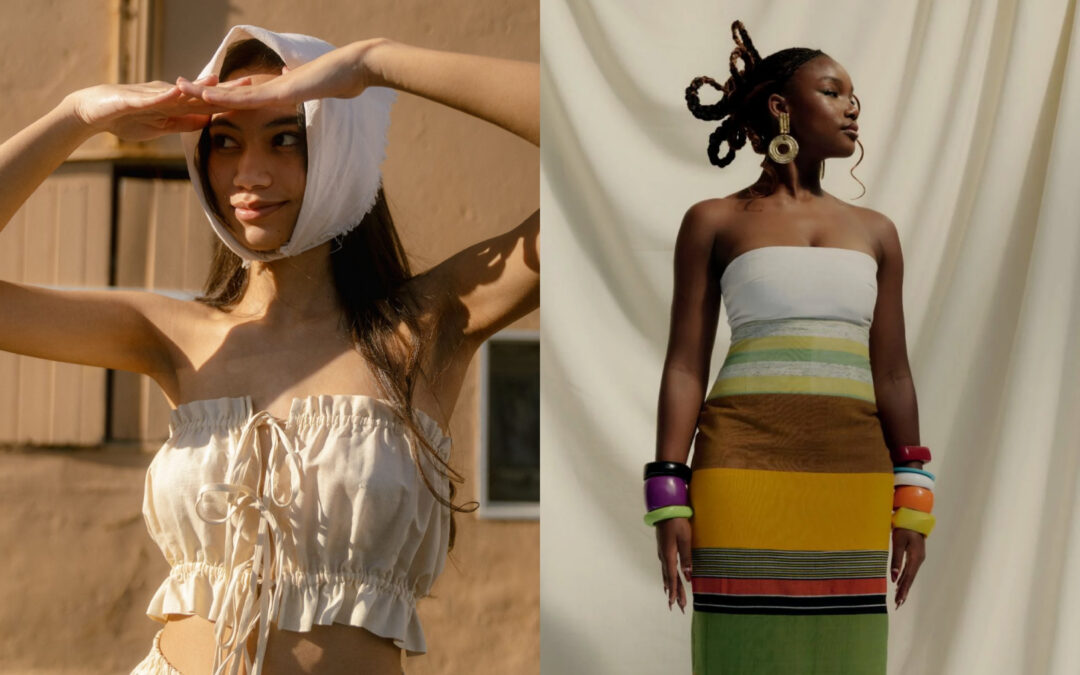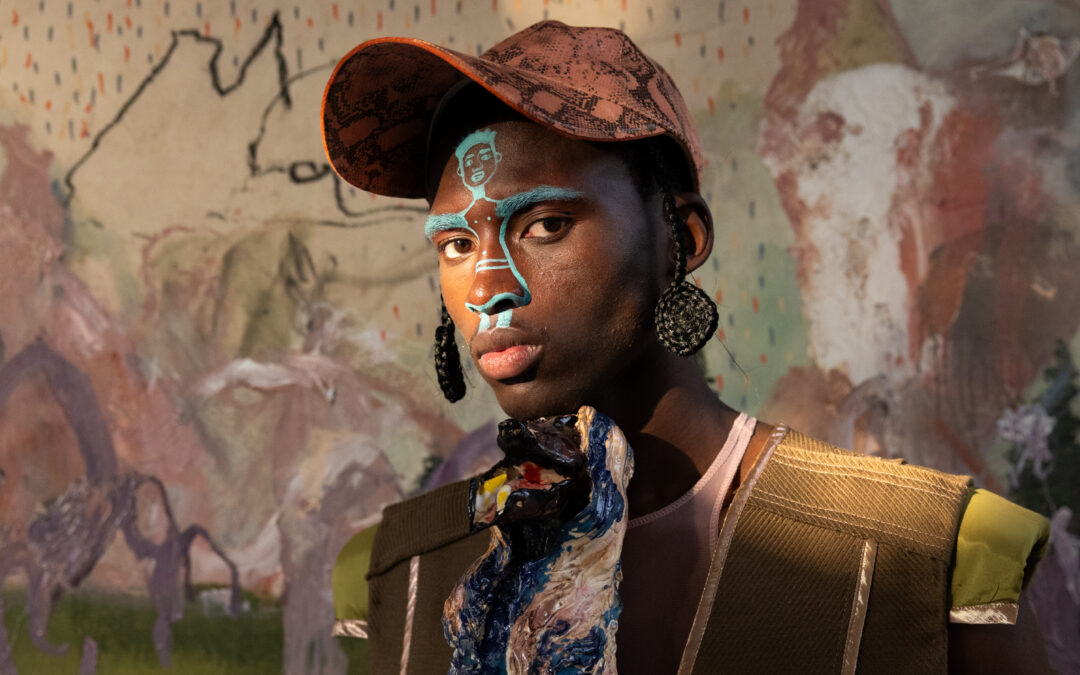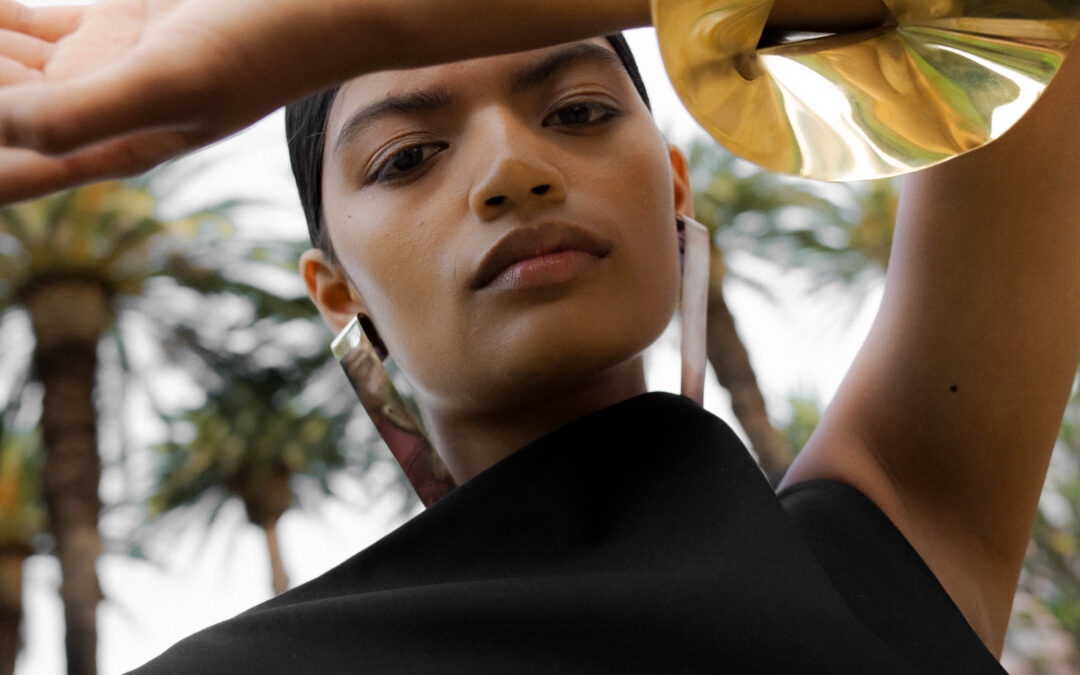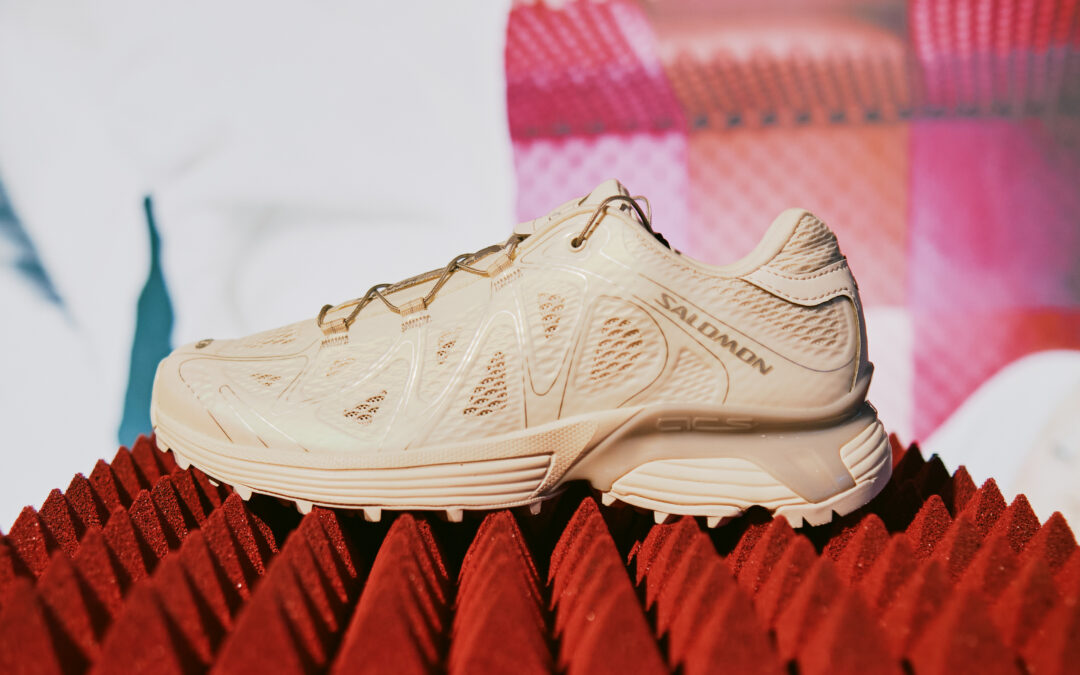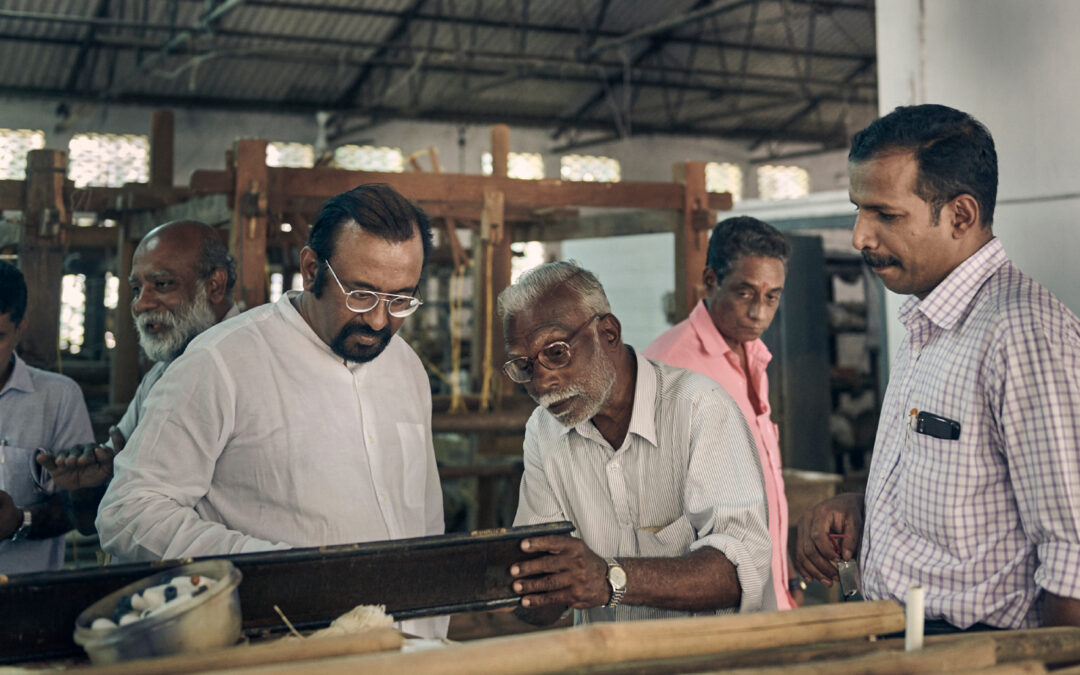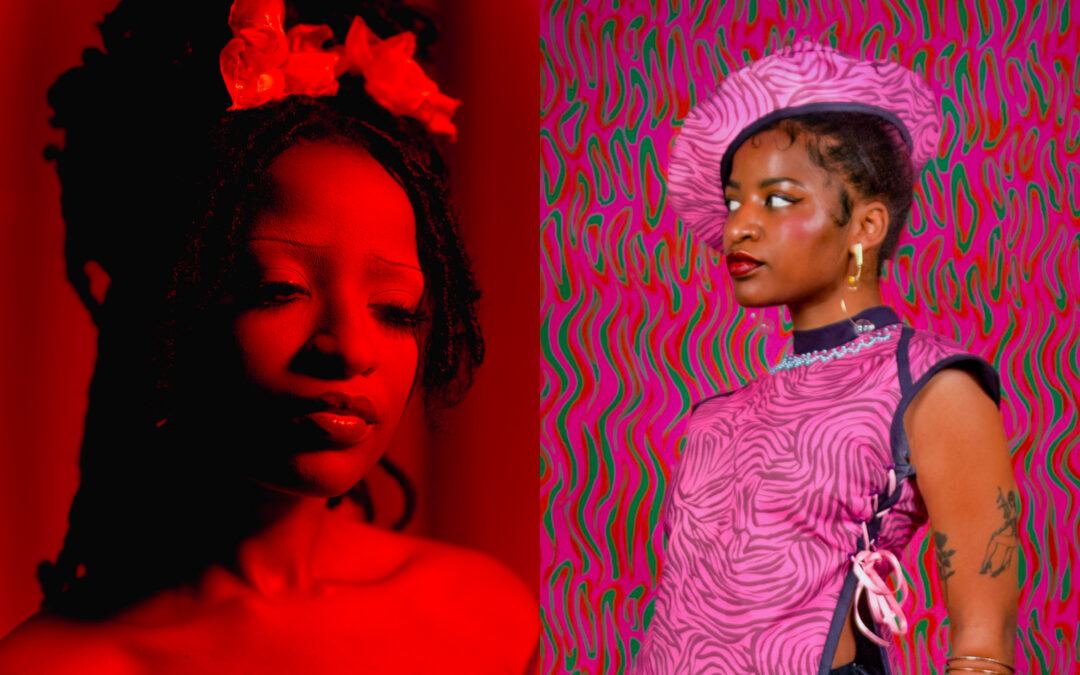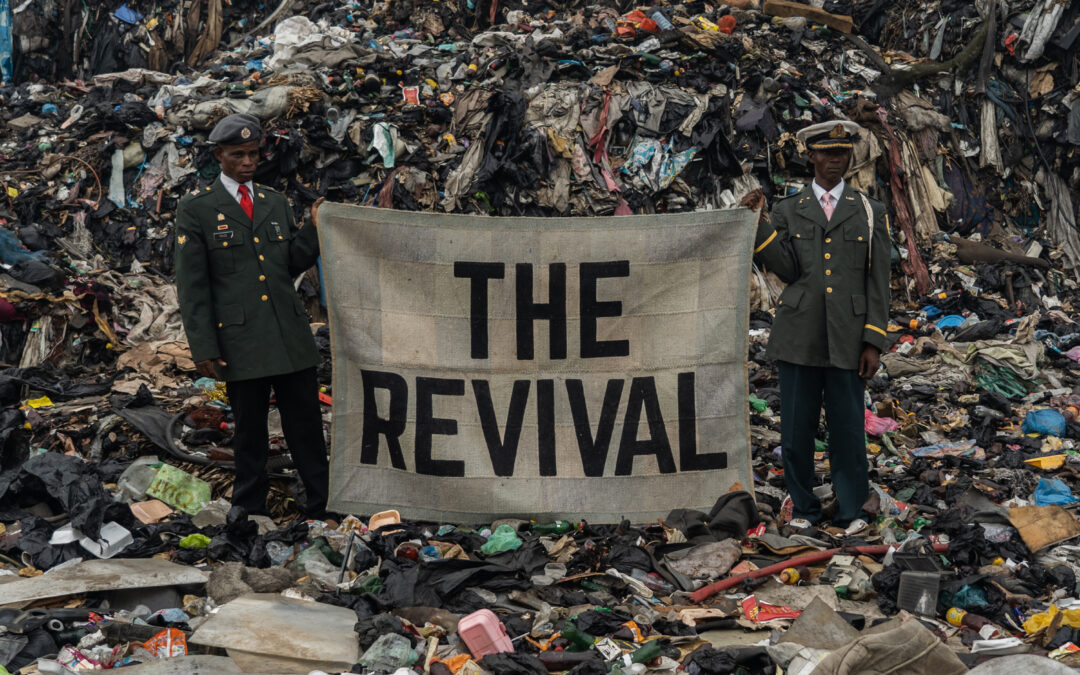There’s a playful revival underway in fashion, and it’s a breath of fresh air.
First, let me set the stage for you – and also remind you of the sub-categories I coined last year to wrap our heads around the ‘big four’ – New York, London, Milan and Paris, which are always in that order on the calendar. New York is fashion’s cool, queer younger sibling, thriving on diversity, inclusivity, and boundary-pushing street style.
London, the quirky DIY cousin, embraces avant-garde experimentation with an ‘anything goes’ attitude, while Milan, the wealthy, child-free aunt, exudes timeless precision, always showcasing immaculate tailoring and luxury.
Paris, fashion’s cerebral, archive-obsessed parent, remains the intellectual heart of fashion, where history and artistry are always in contention and collision. Together, these cities represent the full spectrum of creativity and influence in the fashion world, and in each of the shows I’ve pulled from this chapter — the main category of ‘Recession Escapism’ is present. In the chaos of this category, an unusual cohesion seems to be permeating between the energy of the four distinct fashion week’s.
I was inspired by fashion trend darling Mandy Lee AKA @olderloserinbrooklyn, who reported from Milan that the industry has taken a big turn. So, what the hell is Recession Escapism, you ask, and why am I using it to define the mood for this season? Simply put, it’s our cultural and psychological tendency to seek distraction and comfort during times of economic downturn, often through entertainment or indulgence. Sensory reprieve is psychologically protective and when a recession hits, the shared financial strain and uncertainty initiates our inclination to escape from the harsh realities of life; turning to activities or products that provide a temporary sense of relief or fantasy.
With September marking the advent of ‘Fashion Month’, the industry’s new year — in which the season cycle for fashion is reset, and fashion week’s kick off around the globe. From early September until late into October, innumerable collections are being shown and the tone, trends and energy of the next two years in fashion begins to be set. As I write this, Paris Fashion Week is underway – the finale week of the ‘big four’ – at historic venues around the city. Though each major city’s fashion shows differ immensely, a common thread has emerged according to fashion journalists and event organisers: this year’s schedules are noticeably slimmed down. Excess shows have been trimmed, and cuts have been made to what is being presented. This act of sartorial prudence aligns with a major force affecting the global stage. Its Fashion’s (with a capital F) attempted restraint and keeping things simple.
While this logistical move is present in many shows, the onset of a global recession often has the opposite effect on the content that inspires them: if fashion is the awning of fantasy carrying us into the future, designers and brands tend to become more whimsical, playful, and daring in their approach. We’ll note this later on, with the ever-austere and brilliant Miuccia Prada and Raf Simons’ SS25 Prada show making bold moves to inject bursts of exuberance and surrealism into their collection, reflecting their own seeming desire for escapism amid challenging times. It feels as though fashion is re-emerging from a kind of chrysalis. Its recently perpetual bad rap of un-inventiveness and regurgitation — with many labels subconsciously uniting to bring joy back to fashion week – reminds us all why we remain so enamoured with this artistic discipline.
Let’s take a look at some key notes from some Spring/Summer 2025 shows and as always, this is but a miniscule sample of what there is to see and catch up from the abundant showcases available.
Eckhaus Latta | NYFW
Eckhaus Latta is the brainchild of Mike Eckhaus and Zoe Latta and since 2011, the label has been a stalwart on the New York fashion scene. For their SS25 collection the brand set the tone for this season with their audacious exploration of deconstruction and simplicity.
Playful Deconstruction: The collection embraced the idea of deconstruction and rethinking simplicity. Pieces were re-imagined designs from previous collections that at first glance seemed complex but revealed themselves to be everyday basics with playful twists, encouraging a sense of discovery and personalisation in how they are worn.
Mutability and Versatility: Inspired by the ‘sample sale find’, many garments, like scrunched cardigans or circular cutout skirts, were facilitated with how they are styled, embodying the designers’ love for garments that feel mutable. This versatility is very recession-proof, allowing customers to wear one piece in a variety of different ways.
Unconventional Presentation: The show itself was a playful and immersive experience, blending the lines between a dinner party and a fashion show. Guests, many of whom wore the latest collection, were spontaneously invited to walk the runway, creating an informal, interactive vibe that reflected Eckhaus Latta’s DIY ethos. This unconventional presentation underscored their ability to mix high fashion with everyday, communal moments, encapsulating a truly, truly New York energy.
ECKHAUS LATTA photographed by Thistle Brown, via Vogue Runway
Collina Strada | NYFW
Hillary Taymour’s Collina Strada label is a titan of using fashion and design as a platform for social issues, and her SS25 show brought viewers back to earth.
Nature-Inspired Playfulness: The collection, titled ‘Touch Grass’ was Taymour’s embrace of an earthy, whimsical spirit during political and social tension reaching fever-pitch as the US edges closer to their elections. Models playfully interacted with the environment, and the show highlighted a connection to nature, such as through a model somersaulting onto the runway and tossing grass at the audience. This sense of playful abandon and grounding in nature resonated with the chaotic, overwhelming times, offering a sense of peace and fun. Very Recession Escapism!
Soft Femininity with a Quirky Edge: The clothes combined a sense of softness and romance with Collina Strada’s signature quirky, experimental style. Saturated prints adorned the runway alongside feminine elements like ruffles, lace, sculpted flowers, and billowing chiffon sleeves adorned dresses, tailored jackets, and shell tops, while pieces like a tweed jacket paired with a poofy miniskirt or those *divine* mesh boots in varying colours added unexpected, playful contrasts. Taymour achieved a balance between playful maximalism and a more grown-up, self-assured refinement.
Eclectic Prints and Subdued Colour Palette: The collection’s prints ranged from vibrantly saturated to washed-out, sun-bleached looks, creating a visual variety that felt both energetic and weathered by nature. Pastel hues dominated the colour palette, grounded by bold turquoise and a series of all-black looks that closed the show. This balance between bright, washed-out, and grounded tones highlighted the season’s theme of finding peace amid chaos.
COLLINA STRADA photographed by Isidore Montag, via Vogue Runway
Off-White | NYFW (usually PFW…)
The late Virgil Abloh’s legacy continues through Ib Kamara’s generationally talented vision, and the label showed in New York for the very first time – despite Abloh having been America, Off-White’s home is in Paris.
Global Inspiration: Ib Kamara drew inspiration from a trip to Ghana with his parents, incorporating fabrics, local craftsmanship, and cultural elements into the collection, which he named Duty Free – a theme reflecting the idea of a young, confident, and global citizen.
Athletic and Sexy Aesthetic: The women’s pieces were built around athletic wear, with plunging v-neck leotards, split-hem leggings, and track jackets tied around the waist for a laid-back, yet sensual look.
Functional Menswear Design: For the men’s collection, Kamara introduced functional elements like zippered panels on vests, jackets, and trousers. These designs added a practical utility to the garments, while maintaining the Off-White aesthetic which remains perennially rooted in streetwear sensibilities.
OFF-WHITE photographed by Isidore Montag, via Vogue Runway
Sandy Liang | NYFW
Founded in 2014, Sandy Liang’s eponymous label is an NYC darling, self-described as being inspired by ‘nostalgia, girlhood, and grandmothers in Chinatown.’ Sandy’s SS25 was a swift departure from her bow-frenzied previous shows.
Spy-Inspired Aesthetic: Liang shifted the fashion narrative from coquette-core to a spy-themed collection for the upcoming summer. Drawing inspiration from the playful gadgetry and style of ‘Totally Spies!’ Liang seemingly sought to create an office-ready uniform that incorporates fun elements reminiscent of spy gear, blending cuteness with functionality.
Targeting a More Mature Audience: While Liang has garnered a younger following, her primary customer base actually consists of young professionals who can afford her pieces. Perhaps responding to critics of Liang’s over-emphasis on childlike references, or perhaps a natural evolution towards maturity, this SS25 collection reflects this transition, featuring business casual attire—like puff blazers and capri sets—paired with youthful elements such as metallic kitten heels. This evolution signals that the Liang girl might be stepping into adulthood while retaining a sense of playful nostalgia.
Versatile and Accessible Designs: The collection focuses on simplicity and versatility, utilising jersey fabrics in vibrant colours for basic silhouettes that can easily transition from day to night. Key pieces like satin tunics and mini dresses offer flexibility, and the introduction of accessories such as sequined chokers enhanced the looks. Liang’s cryptic statement during the show’s closing, about each piece being ‘password protected’, hints at the personal and imaginative possibilities of world-building that she’s attempting.
SANDY LIANG photographed by Filippo Fior, via Vogue Runway
JW Anderson | LFW
Northern Irish designer JW Anderson’s eponymous label has been around since 2008 and has been a maverick of an unconventional design within London’s contemporary scene. A slightly restrained SS25, Anderson focused on technical details to assert his collection message.
Minimalist Silhouettes with Conceptual Design: The collection featured stripped-down, mini silhouettes with recognisable pieces like sweaters, sweatshirts, and bombers, alongside more conceptual designs like leather tutu-dresses. Anderson noted that his focus was on minimalism and rethinking excess in fashion – though in true Anderson spirit, his version of minimalism is still ever-so-slightly surreal!
Refocusing Fashion Amid Industry Transition: Anderson expressed the need for the fashion industry to refocus and self-assess, especially after years of excess, and the show emphasised the importance of narrowing down and simplifying, reflecting the broader transition happening in the world.
Creative Playfulness with Brand Signatures: Despite the minimal approach, Anderson maintained creativity through techniques like knitting and trompe l’oeil, while also reintroducing brand signatures such as paisley print dresses and sweater dresses mimicking high-rise buildings. One thing about JW, we are going to see life-like prints somewhere.
JW ANDERSON photographed by Filippo Fior, via Vogue Runway
Chopova Lowena | LFW
Darling of the London fashion scene, Chopova Lowena is an English-Bulgarian label established by visionary designers Emma Chopova and Laura Lowena. Chopova Lowena juxtaposes Bulgarian folklore with a myriad of kaleidoscopic references every single time, and SS25 was no exception.
Victorian Wild West Inspiration: The collection was inspired by female folk heroines of the American Wild West, such as Annie Oakley and Calamity Jane, with influences from rhythmic gymnastics and Olympic costumes, particularly from the ’80s and ’90s.
Signature Pleated Skirts and Layered Styling: Chopova Lowena’s iconic knife-pleated, carabiner-suspended skirts, originally inspired by Bulgarian folk costumes and outdoor sports, were showcased in various iterations. The collection featured elaborate layering with Victorian blouses, petticoat skirts, and a mix of sporty and folk elements.
Creative Accessories and Collaborations: The collection included standout accessories like cutlery in the hair, toy horse necklaces, and a collaboration with Asics, featuring trainers adorned with oversized metal butterflies. Additionally, they introduced scented products made from Bulgarian rose oil, extending their business into fragrances and candles. One thing about the Chopova Lowena gals — they’re going to make your eye work intensely to assess all the details.
CHOPOVA LOWENA backstage photographed by Acielle for Style Du Monde, via Vogue Runway
Simone Rocha | LFW
Irish-Chinese fashion designer Simone Rocha is the mother of romanticism and whimsy in the fashion scene — along with Sandy Liang, she is credited with the resurgence of coquette-aesthetics and hyper-femininity in the fashion space.
Dance as a Core Reference: Rocha drew inspiration from dance, particularly the works of Michael Clark and Pina Bausch. The collection prominently featured floral motifs reminiscent of Bausch’s Nelken, appearing in various forms such as on dresses, accessories, and as always, the Rocha signature embellishments, emphasising a blend of performance and personal expression.
Ambiguity Between Private and Performative: The collection blurred the lines between private and public personas, incorporating elements like tutu skirts in negligées and formal coats with playful cuts. This reflected a theatricality akin to dancers transitioning between rehearsals and performances, suggesting a complex interplay between intimacy and exhibition. As we’ll see later, movement is a key Recession Escapism theme — with Ferragamo similarly exploring dance as a sartorial reference.
Diverse Inspirations and Accessories: Rocha’s collection included a wide range of designs, from embellished menswear to indigo denim, all rich with detail and meaning. Accessories featured playful innovations like ballet slippers with driving shoe soles and embellished Crocs — all very, very Simone-esque and romantic.
SIMONE ROCHA photographed by Filippo Fior, via Vogue Runway
Prada | MFW
Miuccia Prada is arguably the mother of all mothers in fashion, and Prada continues under co-collaboration with Belgian design icon Raf Simons.
Scepticism of Algorithmic Influence: Prada and Simons are questioning the impact of social media algorithms on personal expression and fashion. During the show, Prada noted that our preferences and knowledge are largely shaped by external influences, indicating a concern about the homogenising effects of platforms like Instagram. This scepticism is evident in their collection, which defies typical trends and encourages individuality — and both designers came to play, as they departed from affixing the signature Prada to almost all the clothing, and even many of the shoes. Also, the SHOES??? I’m going to need those piercing-ball heeled loafers, stat.
Unconventional Design: The collection showcased a bold mix of styles, blending elements of superhero aesthetics, BDSM, and cowboy Americana. With goggle hats, porthole skirts, and skirts suspended from harnesses, the designs were intentionally disjointed, emphasising a lack of a singular theme. This approach reflects a desire to break away from conventional fashion narratives and the collection was unusually eccentric for both Raf and Miuccia — we love to see it.
Encouragement of Individuality: Prada and Simons have always advocated for a fashion landscape that embraces personal style and creativity. They challenge the notion of “quiet luxury” and the conformity prevalent in modern fashion, promoting the idea that there are no rules for mixing and matching pieces. The collection left me feeling encouraged to experiment and combine seemingly disparate elements — and reassert my former quirky ways!
PRADA details photographed by Armando Grillo, via Vogue Runway
Bottega Veneta | MFW
Bottega Veneta’s continued domination in Milan is part and parcel of creative director Matthieu Blazy’s contribution to a new, modern vision of Italian design.
Childhood Inspiration and Playfulness: Blazy centred the collection around the theme of childhood wonder, evoking nostalgia through oversized silhouettes and whimsical designs. Pieces like too-big jackets, one-leg pants, and dresses with playful details—such as frogs and bunny-shaped lapels—highlight the joy and imagination associated with early fashion experiences. This playful approach contrasts with the often serious nature of high-end fashion, allowing for a more lighthearted atmosphere.
Unique Set Design and Conceptual Presentation: The show featured vibrant, animal-shaped bean bag chairs, inspired by the movie E.T, creating a nostalgic and inviting environment that made the audience feel youthful and excited. The design of the seating set the tone for the show, as the audience were invited to relax and be curious before the show began.
Craftsmanship and Elevated Essentials: Blazy successfully balances playful designs with high-quality craftsmanship, as seen in the use of materials and techniques. With usual Bottega-tailoring, accessories took on a whole new meaning; with gorgeous hand-knitted flowers, bags that read like shoppers, a latticed leather ukulele case and more. Many of the models were carrying a number of accessories, making the collection feel like a livable and wearable assortment of everyday heirlooms. Other unusual pieces from spiked leather wigs to unique bags made from leather vests crafted by students, demonstrated Blazy’s commitment to building his Bottega legacy through humour and creativity.
BOTTEGA VENETA by GoRunway.com, via Vogue Runway
Ferragamo | MFW
One of the youngest creative directors ever appointed at a historic fashion house, and the first Black designer at the helm of an Italian luxury brand, Maximilian Davis has revitalised Ferragamo in untold ways — while being one of the few designers to instantly nail the respect of house codes while maintaining personal originality.
Dance as a Central Theme: Davis’ collection draws heavily from the world of dance, particularly highlighting the connection to legendary figures like Katharine Dunham and Rudolf Nureyev, who both embodied grace and artistry. This thematic focus allowed Davis to explore the interplay between movement and fashion, using historical references to inform contemporary designs that celebrate fluidity and expression.
Innovative Textiles and Structures: The collection featured an array of textiles, including metal-spiked nylon and washed denim, enhancing the tactile quality reminiscent of artist Piero Manzoni’s work. Pieces like loose trench coats, sectioned skirts, and parachute dresses demonstrated a balance between structured and flowing silhouettes, creating a dynamic visual impact while echoing the physicality of dance. The use of fringe and asymmetric designs added a sense of playfulness and movement to the garments. Personally, I though the tonal narrative of the collection is the best I’ve seen in a very, very long time; bold crimson, rusts, salmon pink, crisp white and the injection of electric blue all worked in staggering unison and felt oh so cleanly Ferragamo, while remaining super fun.
Elegance Meets Athleticism: Davis successfully fused classic ballet aesthetics with modern sportswear influences, presenting looks that included fitted knit dresses, double-wrapped tops, and block-colour silk-mix pieces. This combination reinforced the elegance associated with ballet; so covetable – and for Davis to choose a high-brow sport as ballet to explore athleticism through the Ferragamo is just genius.
FERRAGAMO photographed by Alessandro Lucioni, via Vogue Runway
Hodokova | PFW
Ellen Hodakova Larsson’s Hodakova is on an accelerated trajectory, with the upcycling-genius, Swedish designer having just won the LVMH Young Designers Prize – becoming the first Swede to win the award.
Upcycling and Personal Nostalgia: Larson’s collection reflects her commitment to upcycling, drawing on her upbringing in the countryside, where she learned the values of ‘make-do and mend.’ The designs evoke warmth and nostalgia while being incredibly bold and daring – as it incorporates deadstock, vintage, and salvaged materials in very surreal ways.
Material Exploration: By transforming unexpected items—such as boots into dresses and using everyday objects like plastic lenses as decorative elements—Larsson blurred the lines between fashion and art, and flexed her hardwon technical ability forged at the Swedish School of Textiles. The playful, surreal elements in her designs, such as multi-zipper dresses and frame dresses made from landscape paintings, highlighted an innate creativity and ability to infuse a sense of wonder into her work.
A Balance of Rustic Charm and Sophistication: While the collection features rustic touches inspired by Swedish country life—like checked dishcloth fabrics and woven belt bags reminiscent of traditional gathering baskets—it also incorporated sophisticated silhouettes. Larson’s aim is to create warmth and harmony in her designs, promoting the idea that comfort and individuality can coexist. She encourages viewers to forge their own paths in fashion, finding beauty and potential in everyday materials and experiences. This is a fabulous code for navigating a global recession, I’d say…
Courtesy of Hodokova via Vogue Runway
YSL | PFW
Anthony Vaccarello has led the charge at Yves Saint Laurent (YSL) since 2016 and is now considered a veteran of luxury design.
Tribute to Yves Saint Laurent’s Aesthetic: Vaccarello’s collection deeply honoured Yves Saint Laurent’s iconic style, particularly through impeccable tailoring and strong silhouettes. The collection began as a seeming ode to Wall-Street stockbrokers of the 1980s – all classic mannish tailoring—double-breasted jackets and wide pants—crafted with precision, for a sense of control. Then, Vaccarello did a massive swerve deep into bejewelled references from the 70s — juxtaposing prints and lace, all in brilliant and bold shades. This contrast was a fever-dream and almost chronologically followed ideas of how Recession Escapism; from severe, professional pursuits and into realms of play and abandon.
Dynamic Use of Textures and Layers: The show’s transition from structured suiting to rich evening wear, incorporating luxurious fabrics like brocade and lace was genius. Featuring fuchsia, hot pink, kingfisher blue, and daffodil yellow—paired with flowing silhouettes and intricate accessories along with the collection’s layering, including pyjama-style dressing and voluminous outerwear, echoed the opulent and eclectic spirit of Saint Laurent’s designs. This is called *respecting House codes*.
Counteracting Industry Trends: In a fashion landscape increasingly dominated by minimalism and uniformity, Vaccarello’s bold choices stood out. By embracing a “done” look—complete with accessories like wide ties, jewelled shoes, and gold bangles—he defied the trend of reductive design. His ability to blend historical references with contemporary flair reaffirmed the house’s legacy and also injected a fresh vibrancy into the season, challenging the notion of safety in modern fashion. Very, very Recession Escapism coded.
YSL photographed by Alessandro Lucioni, via Vogue Runway
Written by: Holly Beaton
For more news, visit the Connect Everything Collective homepage www.ceconline.co.za

